Table of Contents
- Introduction
- Editor’s Choice
- Alopecia Market Overview
- Leading Hair Concerns Among People
- Baldness Prevalence Statistics
- Symptoms of Hair Loss
- Reasons for Hair Loss
- Baldness Dynamics – By Gender Statistics
- Baldness Dynamics – By Age Group Statistics
- Baldness Dynamics Among Men Statistics
- Baldness Dynamics Among Women Statistics
- Baldness Treatments and Remedies Statistics
- Baldness Treatment Cost Statistics
- Key Investment Trends
- Innovations and Developments in Hair Transplant Technology
- Recent Developments
- Conclusion
- FAQs
Introduction
Baldness Statistics: Baldness, or hair loss, primarily manifests in several forms. Including androgenetic alopecia (the most common type), alopecia areata (an autoimmune condition), telogen effluvium (temporary shedding due to stress or hormonal changes), and traction alopecia (caused by tight hairstyles).
Key factors influencing baldness include genetics, hormonal changes, medical conditions, and lifestyle factors such as stress and nutrition.
Preventive measures, like a balanced diet and stress management, can support hair health. At the same time, treatments range from topical solutions like minoxidil and oral medications like finasteride to surgical options such as hair transplants.
Understanding these aspects is crucial for those affected, and consulting with a healthcare provider can help identify appropriate treatments.
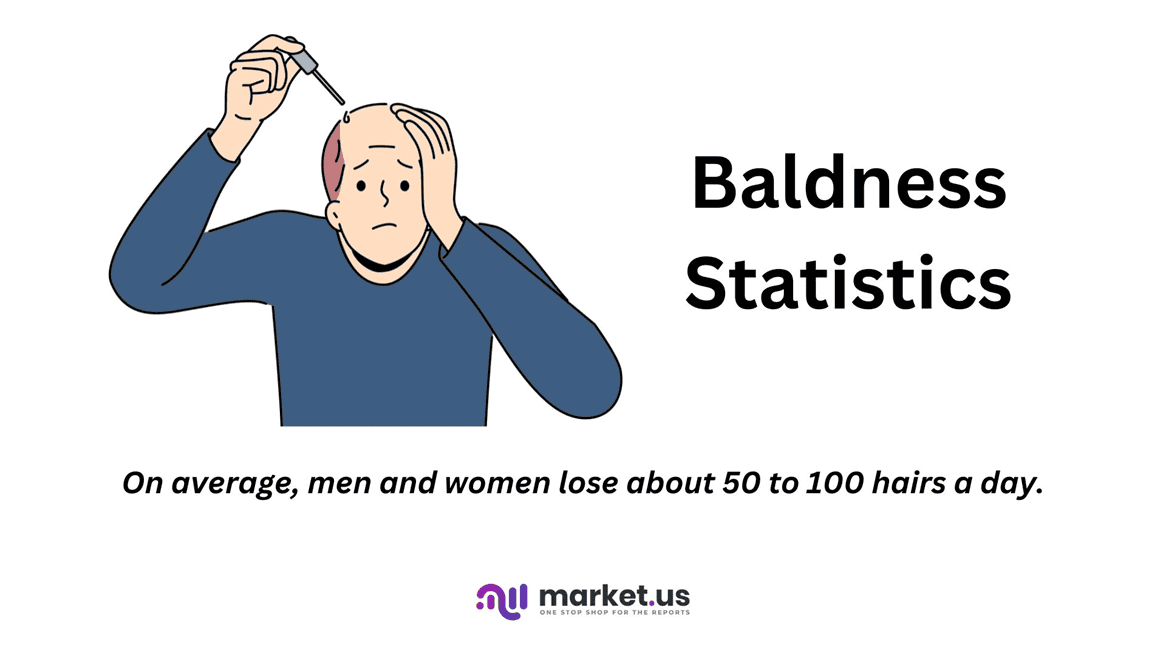
Editor’s Choice
- The global alopecia market revenue is expected to reach USD 24.7 billion by 2033.
- As of March 2022, the leading hair concerns among people in Singapore varied widely. Hair loss was the top concern, cited by 44.38% of respondents.
- In 2024, male pattern baldness prevalence varies significantly across countries. Spain leads with 44.50% of its male population affected.
- In 2022, male consumers in South Korea reported various symptoms of hair loss. The most common symptom was thinning hair, experienced by 36% of respondents.
- In 2022, young people in China identified several leading reasons for hair loss. Staying up late was cited by 58.90% of respondents as the primary cause.
- As of December 2020, hair loss issues were prevalent among both genders in China. With a higher percentage of females affected. Approximately 30% of female respondents reported experiencing alopecia, compared to 19% of males.
- In 2018, the age distribution of people in China who began experiencing hair loss showed variation across different age groups. The highest proportion, 22.10%, was seen among individuals aged 25-30 years.
- The global alopecia drugs market revenue is projected to reach USD 23.1 billion by 2033.
- In 2020 and 2021, the total cost of hair transplants varied significantly across different countries. Canada had the highest cost, with an average of USD 17,500.

Alopecia Market Overview
Global Alopecia Market Size
- The global alopecia market is projected to experience steady growth from 2023 to 2033.
- In 2023, the market size is estimated at USD 9.1 billion and is expected to rise to USD 10.1 billion by 2024.
- The market is forecasted to continue its upward trend. Reaching USD 11.1 billion in 2025 and USD 12.3 billion by 2026.
- By 2027, the market is anticipated to grow to USD 13.6 billion, followed by USD 15.0 billion in 2028.
- In subsequent years, the market is projected to reach USD 16.6 billion by 2029, USD 18.3 billion by 2030, and USD 20.2 billion by 2031.
- The global alopecia market is expected to expand further. Reaching USD 22.4 billion by 2032 and USD 24.7 billion by 2033.
- This growth reflects increasing demand for alopecia treatments and solutions worldwide over the next decade.
(Source: market.us)
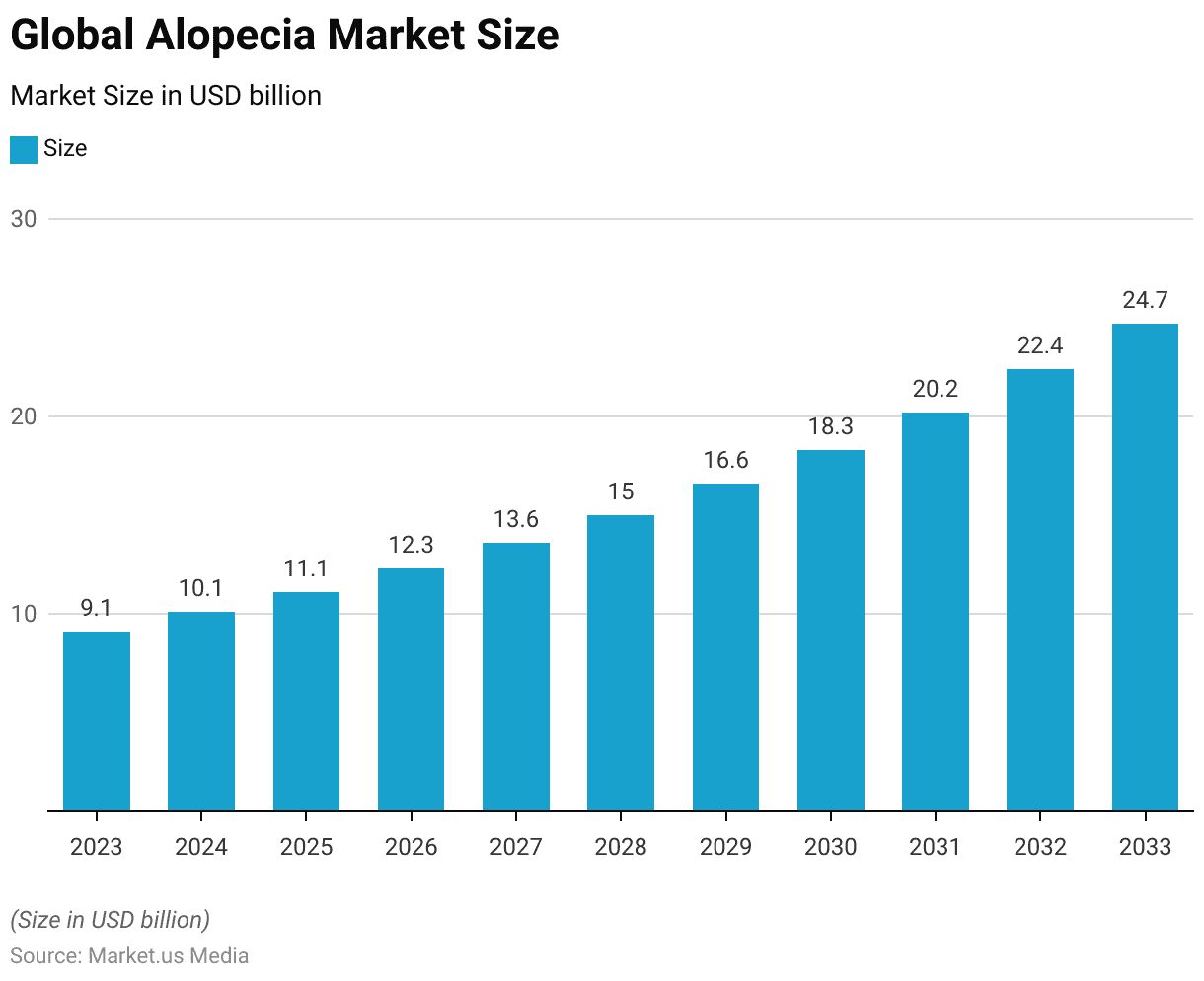
Leading Hair Concerns Among People
- As of March 2022, the leading hair concerns among people in Singapore varied widely.
- Hair loss was the top concern, cited by 44.38% of respondents. Followed closely by concerns about dry or damaged hair, affecting 43.27%.
- Frizzy hair was a concern for 37.51%, while 31.85% dealt with oily scalp issues.
- Thinning hair was noted by 29.25% of respondents, and 27.39% were troubled by limp or flat hair.
- Split ends were a concern for 23.96%, followed by dandruff (17.18%) and itchy scalp (15.32%).
- Greying hair was mentioned by 13.18%, and brittle hair by 12.63%.
- Concerns about dull hair affected 10.68%, while 9.94% had issues with pimples on the scalp.
- Damaged hair due to constant bleaching was a concern for 8.73%, while unmanageable hair affected 8.64%.
- Fewer respondents were concerned about their hair being too straight (6.41%), dry scalp (6.13%), hair being too curly (5.94%), or too voluminous (3.34%).
(Source: Statista)
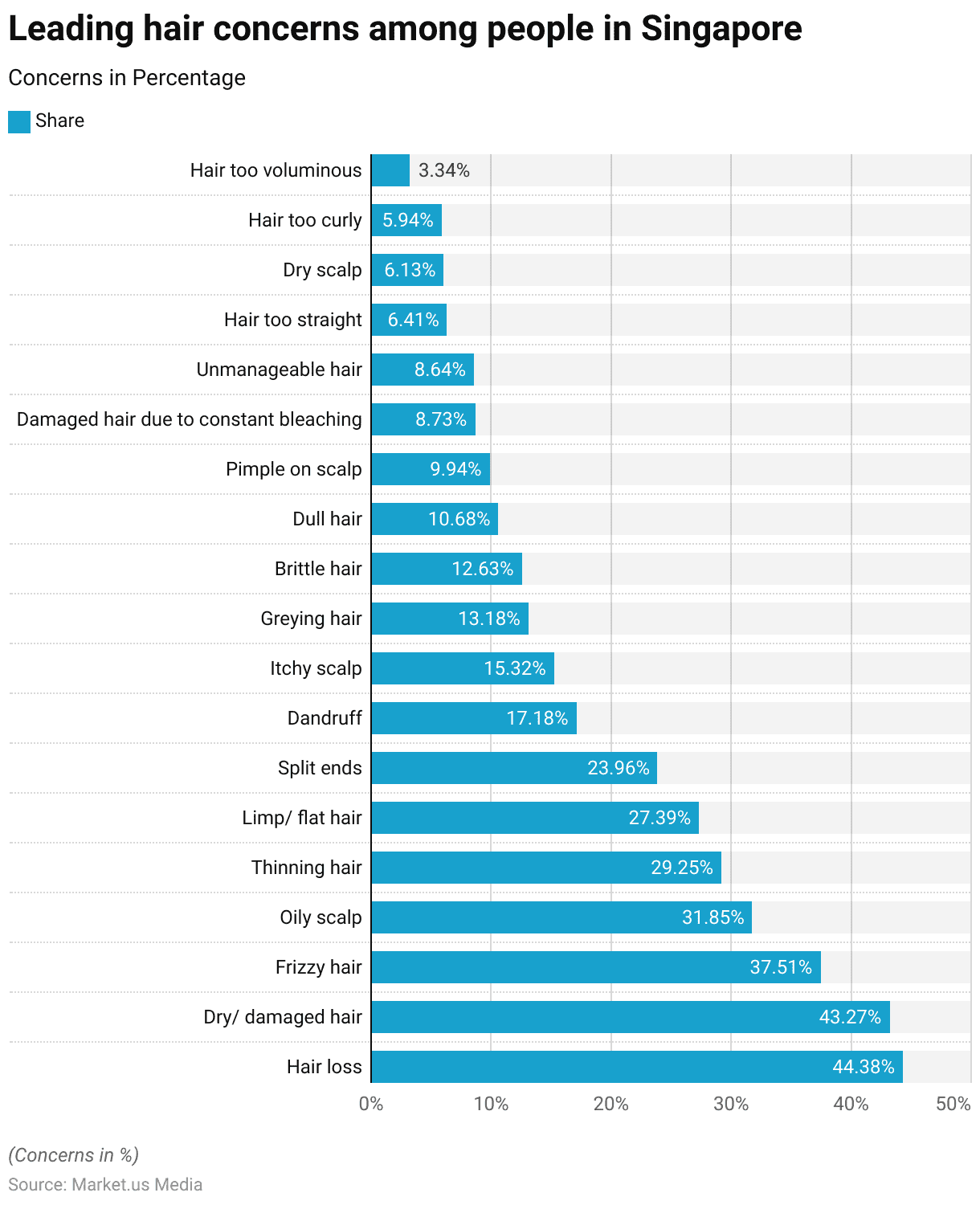
Baldness Prevalence Statistics
Global Baldness Prevalence Among Men – By Country Statistics
- In 2024, male pattern baldness prevalence varies significantly across countries.
- Spain leads with 44.50% of its male population affected. Closely followed by Italy at 44.37% and France at 44.25%.
- The United States records a prevalence of 42.68%, while Germany stands at 41.51%.
- In Croatia, the rate is slightly lower at 41.32%, with Canada (40.94%) and the Czech Republic (40.90%) showing similar figures.
- Australia (40.80%), Norway (40.75%), and New Zealand (40.19%) maintain rates around 40%.
- The United Kingdom sees 40.09% of males experiencing baldness, while Turkey reports 40.03%. Mexico and Saudi Arabia share a 39.75% rate.
- In Ireland, the figure is 38.65%, Switzerland follows at 38.53%, and Russia records 38.28%.
- The United Arab Emirates reports a prevalence of 38.10%, while Hungary reports 37.68%. Belgium (36.04%), Japan (35.69%), and Sweden (35.14%) exhibit lower rates.
- Lastly, Iran has 35.03% of males affected, with Finland showing the lowest figure in this data set at 34.52%.
(Source: World Population Review)
Take advantage of our unbeatable offer - buy now!

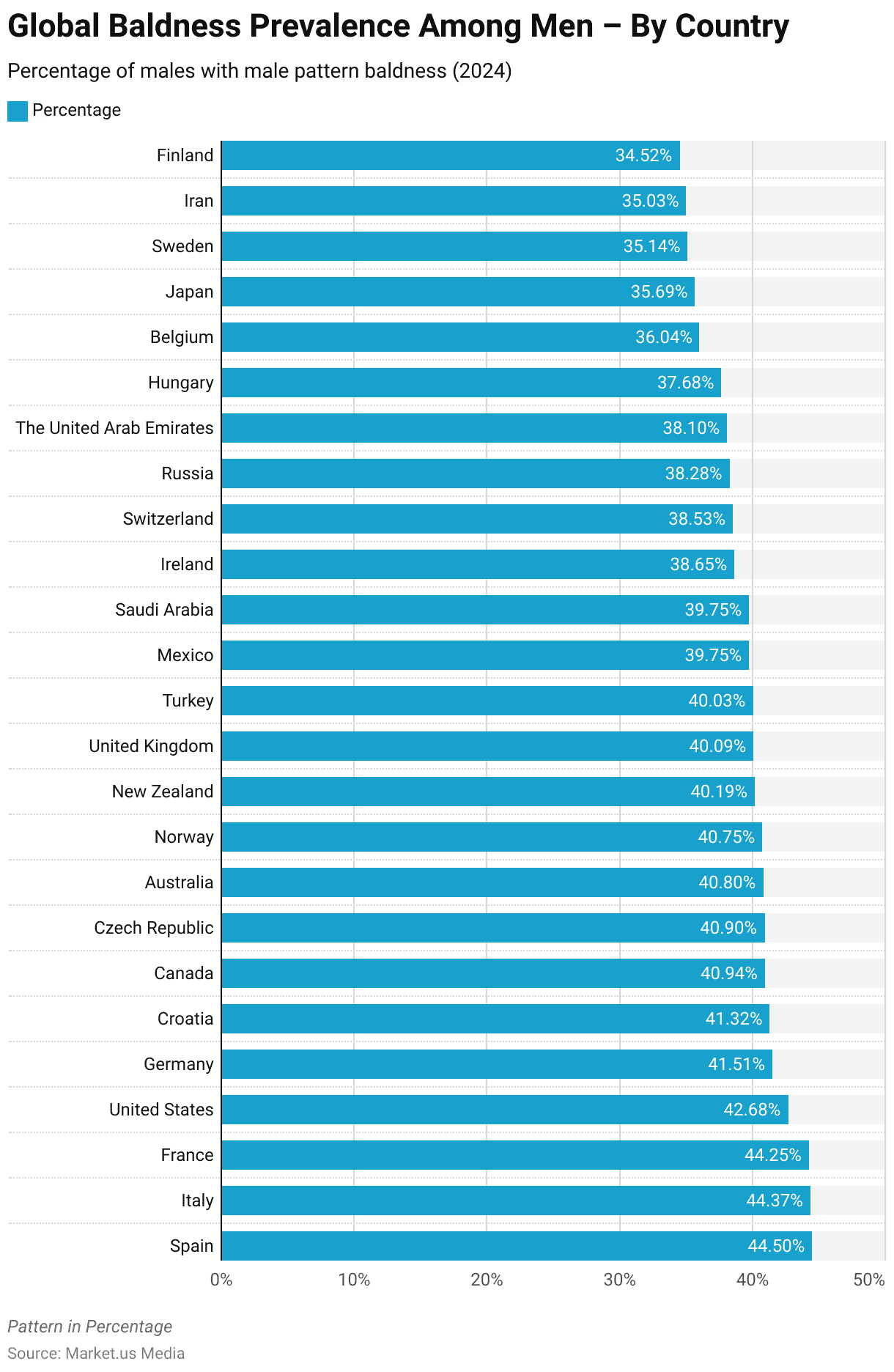
Global Hair Loss/ Baldness Prevalence Among Women – By Country Statistics
- The share of women experiencing hair loss has increased in several selected countries between 2017 and 2021.
- In the Chinese Mainland, the percentage rose significantly from 31% in 2017 to 53% in 2021.
- Brazil saw a modest increase, with 28% of women reporting hair loss in 2017 compared to 30% in 2021.
- In Spain, the prevalence grew from 20% to 25% over the same period.
- Germany experienced a slight rise, from 16% in 2017 to 17% in 2021, while France saw an increase from 12% to 15%.
- In the United States, the percentage of women reporting hair loss went up from 11% to 12%, and Great Britain saw the smallest increase, from 6% in 2017 to 9% in 2021.
(Source: Statista)
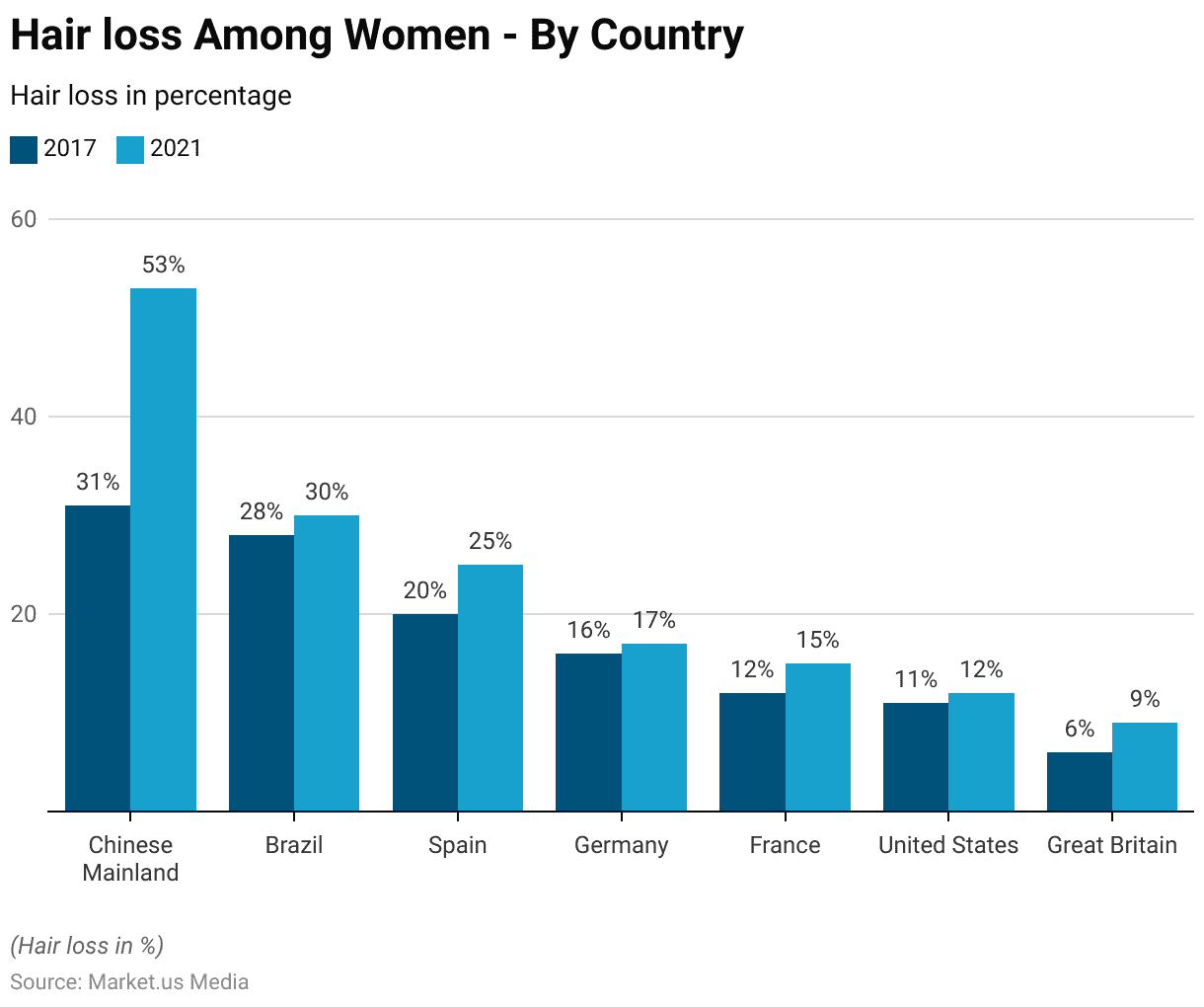
Symptoms of Hair Loss
- In 2022, male consumers in South Korea reported various symptoms of hair loss.
- The most common symptom was thinning hair, experienced by 36% of respondents.
- Additionally, 29% noted significant hair loss when combing, while 27% reported M-shaped hair loss.
- Hair loss at the crown was identified by 18.50% of men, and 15.90% experienced persistent itchy scalp and dandruff.
- A smaller percentage, 7.90%, observed losing more than 100 hairs per day, while 7.20% reported circular hair loss.
- U-shaped hair loss affected 4.20% of respondents, and notably, 28.20% of men indicated experiencing no symptoms of hair loss.
(Source: Statista)
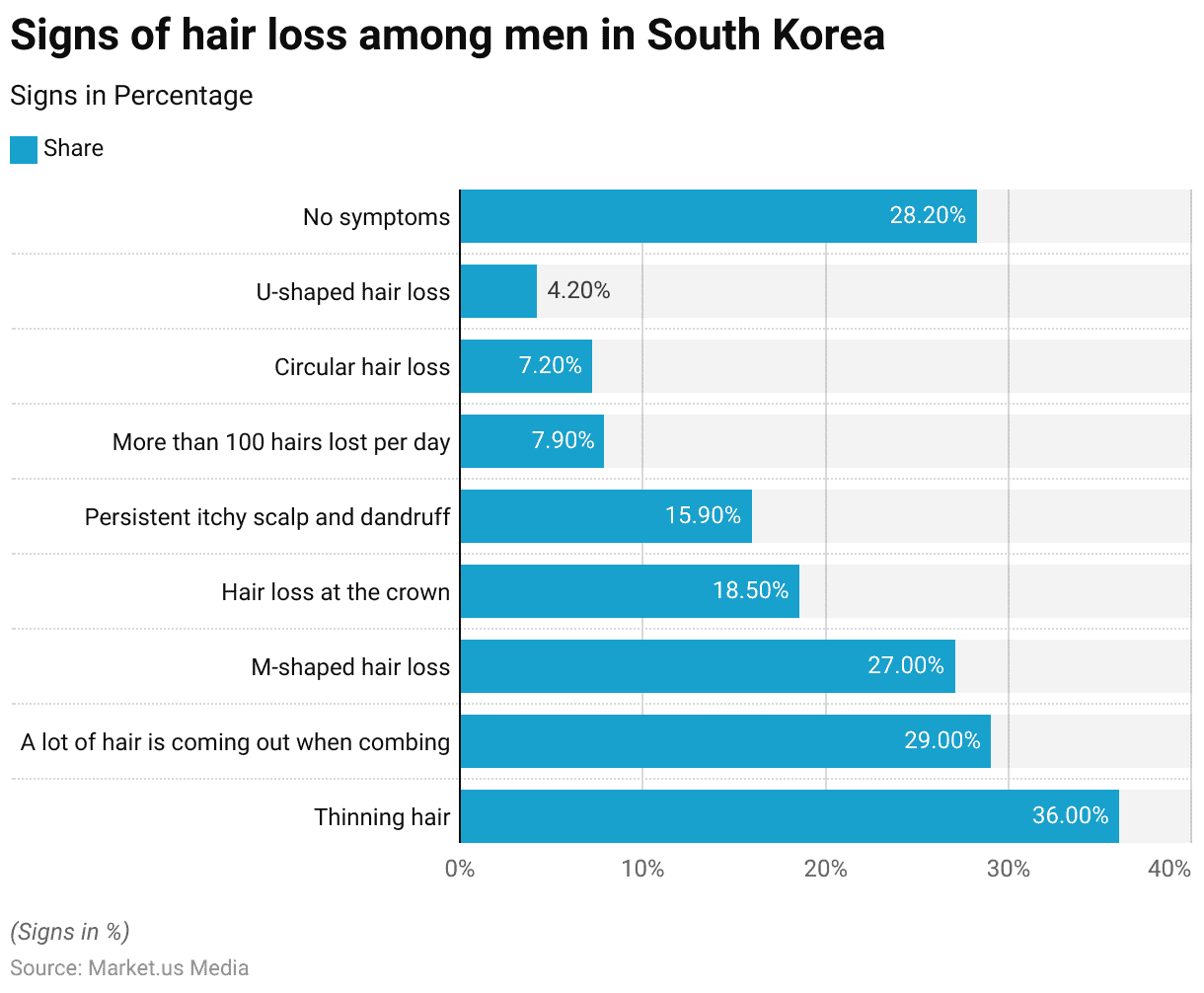
Reasons for Hair Loss
- In 2022, young people in China identified several leading reasons for hair loss.
- Staying up late was cited by 58.90% of respondents as the primary cause. Followed closely by mental stress, which 55.60% attributed to their hair loss.
- Irregular diets were reported by 44.80% as a contributing factor, while 43.70% pointed to endocrine disorders.
- Excessive use of the brain at work or study was mentioned by 35.90%, and bad hair care habits were cited by 32% of respondents.
- Incorrect ways of washing hair were identified by 25%, and 22.80% attributed frequent scalp damage as a cause.
- Additionally, 18.10% believed improper use of hair products contributed to their hair loss, and 14.20% cited genetics as a factor.
(Source: Statista)

Baldness Dynamics – By Gender Statistics
Share of Young Adults Facing Hair Loss Problems – By Gender
- In 2022, a significant portion of young people in China reported experiencing hair loss, with a higher prevalence among females.
- Approximately 44.60% of young women indicated hair loss issues, compared to 32.80% of young men.
- This data underscores a notable gender disparity in hair loss among China’s youth during that year.
(Source: Statista)

Prevalence of Alopecia – By Gender
- As of December 2020, hair loss issues were prevalent among both genders in China. With a higher percentage of females affected.
- Approximately 30% of female respondents reported experiencing alopecia, compared to 19% of males.
- This data highlights a notable gender difference in the prevalence of hair loss in the country during this period.
(Source: Statista)

Incidence of Hair Loss – By Gender
- As of April 2017, a significant share of consumers in Brazil reported suffering from hair loss. With a notable difference between genders.
- Among respondents, 45% of women claimed to experience hair loss, compared to 18% of men.
- On average, 32% of Brazilian consumers indicated they were affected by this condition during that period.
(Source: Statista)
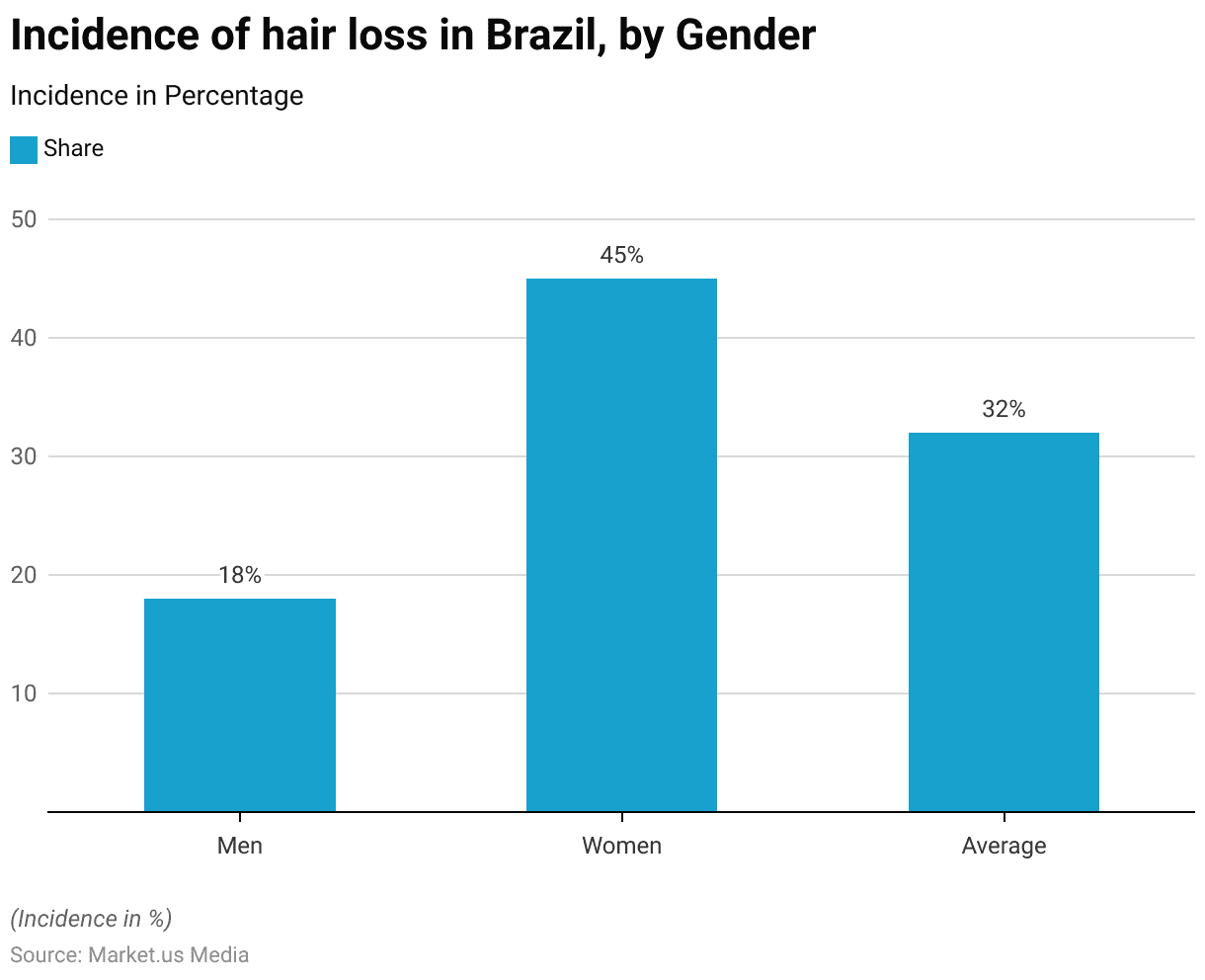
People with Hair Loss – By Gender
- In 2020, the number of people experiencing hair loss in China reached significant figures, with a higher prevalence among males.
- Approximately 164 million men in China were affected by hair loss, compared to 87 million women.
- This data highlights the substantial scale of hair loss issues across both genders in the country during that year.
(Source: Statista)
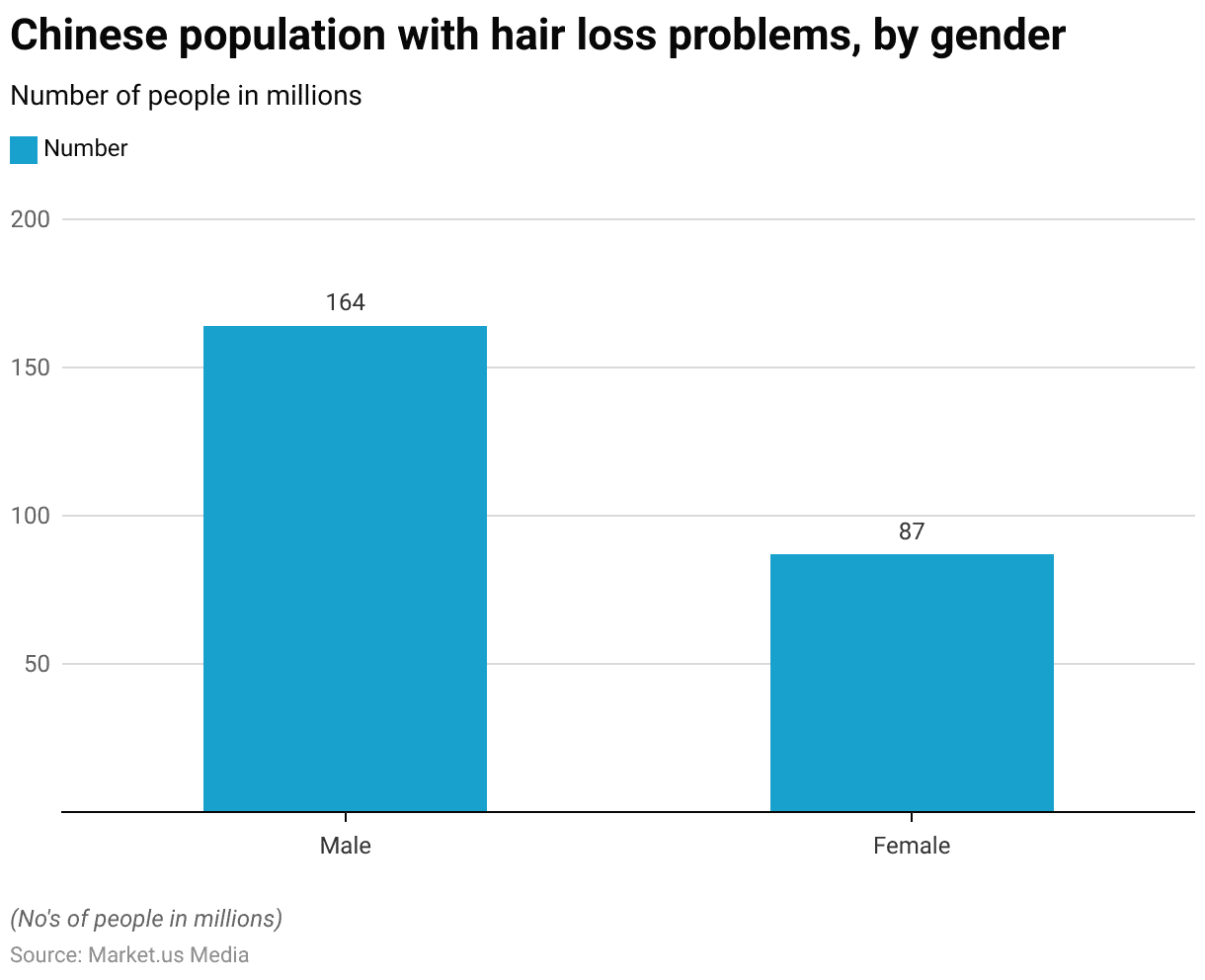
Baldness Dynamics – By Age Group Statistics
Prevalence of Alopecia – By Age Group
- As of December 2020, the prevalence of hair loss in China varied across different age groups.
- Among younger individuals aged 11-20 years and 21-25 years, 33% of respondents reported experiencing hair loss.
- The proportion slightly decreased to 29% among those aged 26-30 years.
- In the 31-40 age group, 23% of individuals were affected, while 21% of those aged 41-50 years experienced hair loss.
- The prevalence dropped significantly among people aged 51 years and older, with only 12% reporting hair loss issues.
- This data highlights that hair loss is a concern across all age groups but tends to decrease with age.
(Source: Statista)
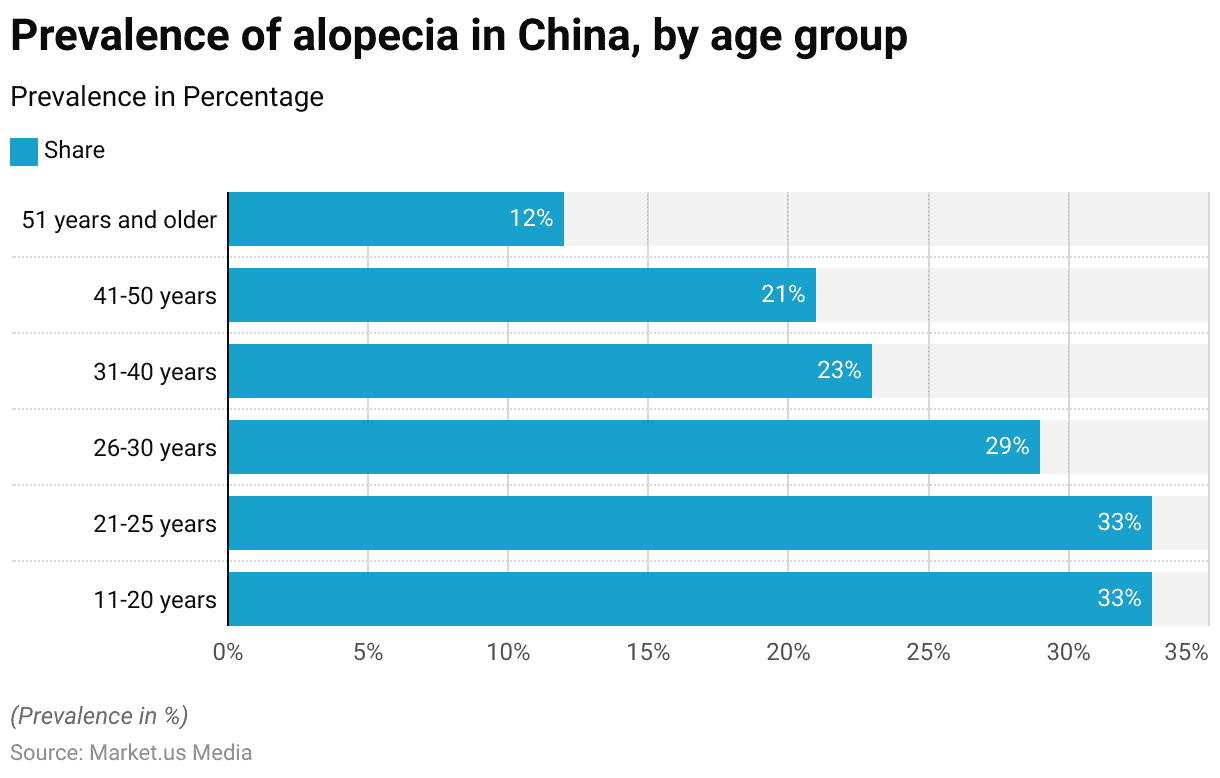
Age Distribution of People Starting to Loose Hair
- In 2018, the age distribution of people in China who began experiencing hair loss showed variation across different age groups.
- The highest proportion, 22.10%, was seen among individuals aged 25-30 years, while 21.80% of people aged above 41 years also reported developing hair loss.
- Among those below 25 years, 21.70% experienced hair loss, followed by 19.30% in the 31-35 age group.
- The prevalence decreased further among individuals aged 36-40 years, with 15.10% starting to lose hair during this period.
- This data indicates that hair loss can begin across a wide age range in China.
(Source: Statista)
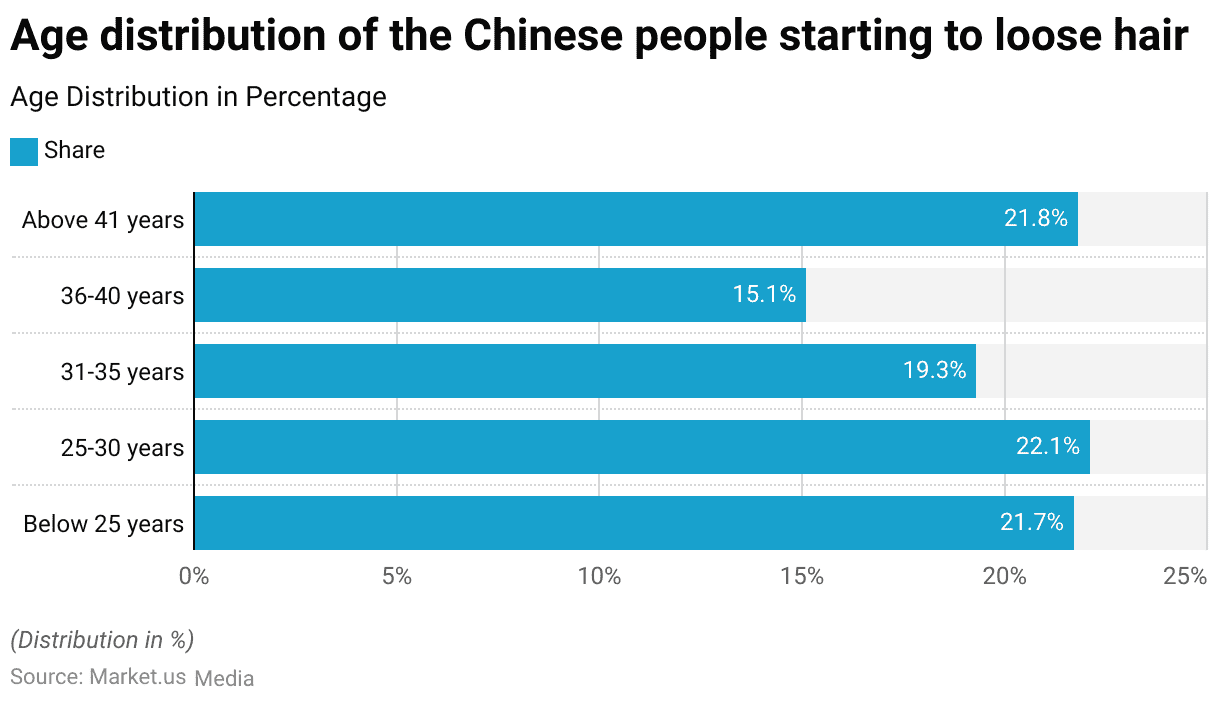
Leading Hair Problems Among Generation X
- In Indonesia, Generation X faces a range of prevalent hair issues.
- Hair fall is the most significant concern, affecting 79.70% of respondents, followed by greying hair at 45.90%.
- Thin hair is an issue for 33.10% of individuals, closely followed by dandruff, affecting 32%.
- Limp or flat hair is reported by 29.70% of the respondents.
- Additionally, 24.40% struggle with dry and frizzy hair.
- Hair damage caused by chemical processes, such as coloring, smoothing, rebonding, and other treatments, concerns 21.50% of Generation X.
- Finally, a smaller proportion, 8.10%, report issues with breakage and split ends.
- These findings highlight a diverse array of hair-related challenges within this demographic group.
(Source: Statista)
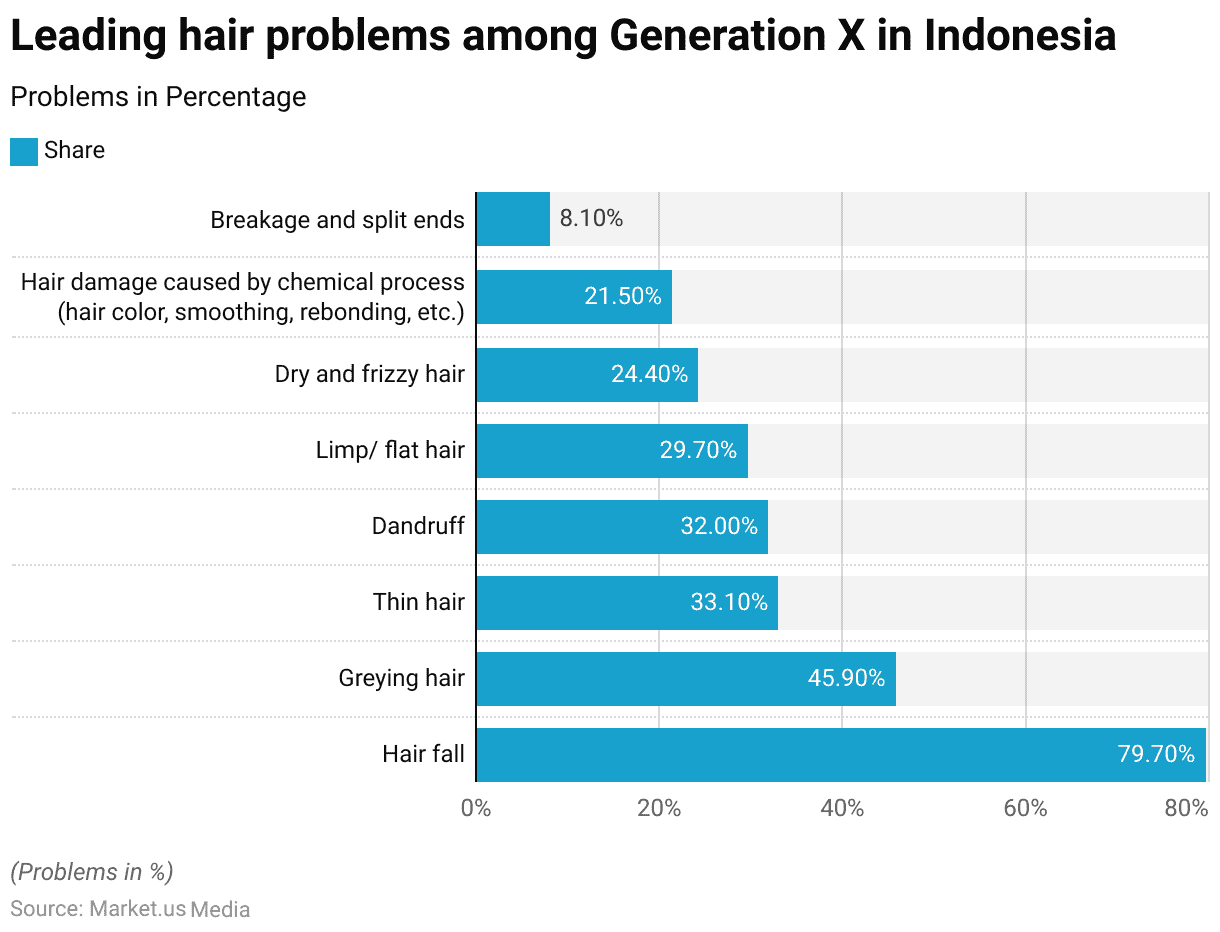
Baldness Dynamics Among Men Statistics
Common Hair-Related Worries Among Men
- As of August 2023, men in Japan expressed various hair-related concerns, with thin hair and hair loss being the most prominent, cited by 23.50% of respondents.
- Grey hair was the second most common worry, affecting 20.80% of those surveyed.
- Concerns about hairstyle followed, with 14.70% of men feeling uneasy about their hair’s style.
- Hair quality, including aspects like bounciness and volume, was a concern for 13.80%, while 11% were troubled by their hair type, such as having curly hair.
- Additionally, 5.70% of respondents mentioned worries about split ends.
- This distribution of concerns reflects a broad range of hair-related issues that affect men’s confidence and appearance in Japan.
(Source: Statista)
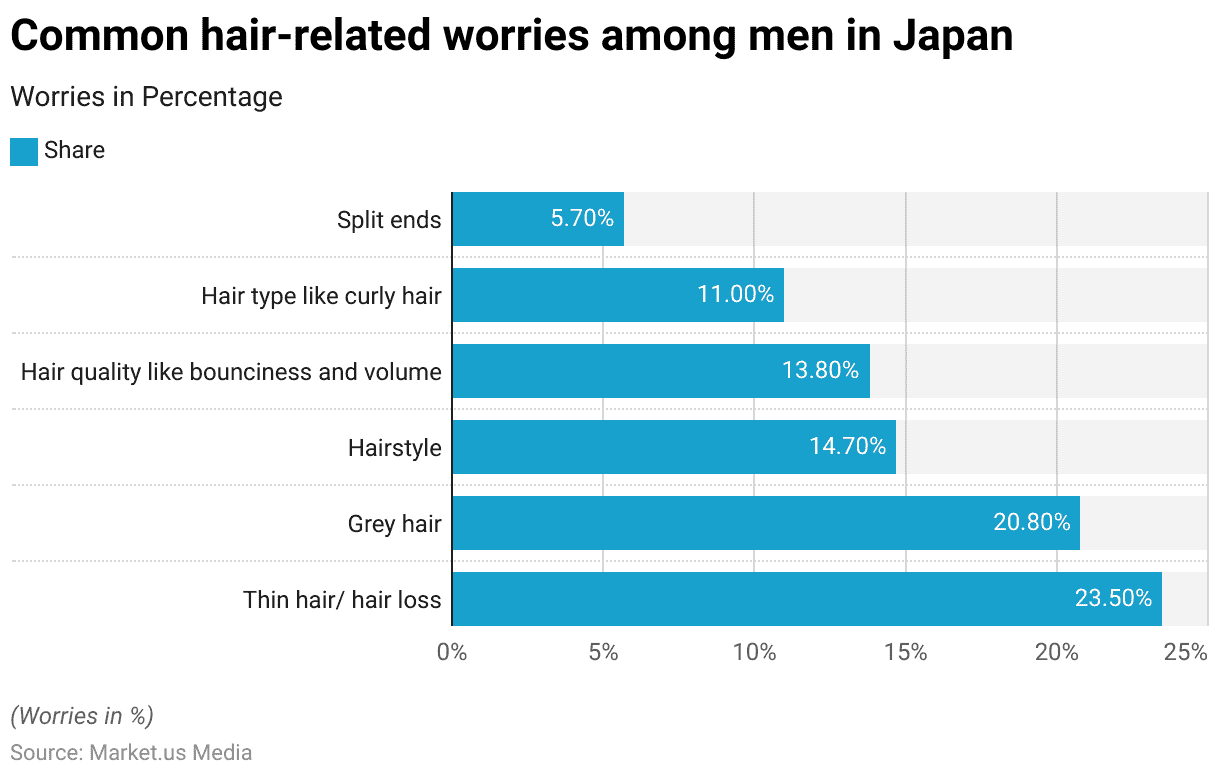
Level of Concern About Hair Loss Among Men
- In 2022, male consumers in South Korea exhibited varied levels of concern regarding hair loss.
- A significant portion, 19.30%, expressed very high worry (rated as five on the scale), indicating substantial anxiety about losing hair.
- Another 30.50% fell into the category of tending to worry a lot (rated as 4), showing a high but slightly less intense level of concern.
- The middle group, rated as 3, comprised 28.30% of respondents who admitted to worrying about hair loss.
- On the other hand, less concern was noted among 9.60% of respondents who tended not to be worried (rated as 2), and 12.30% were not worried at all about hair loss (rated as 1).
- This distribution highlights a predominant trend of concern among a majority of the male population regarding hair loss, with a notable portion experiencing significant anxiety.
(Source: Statista)
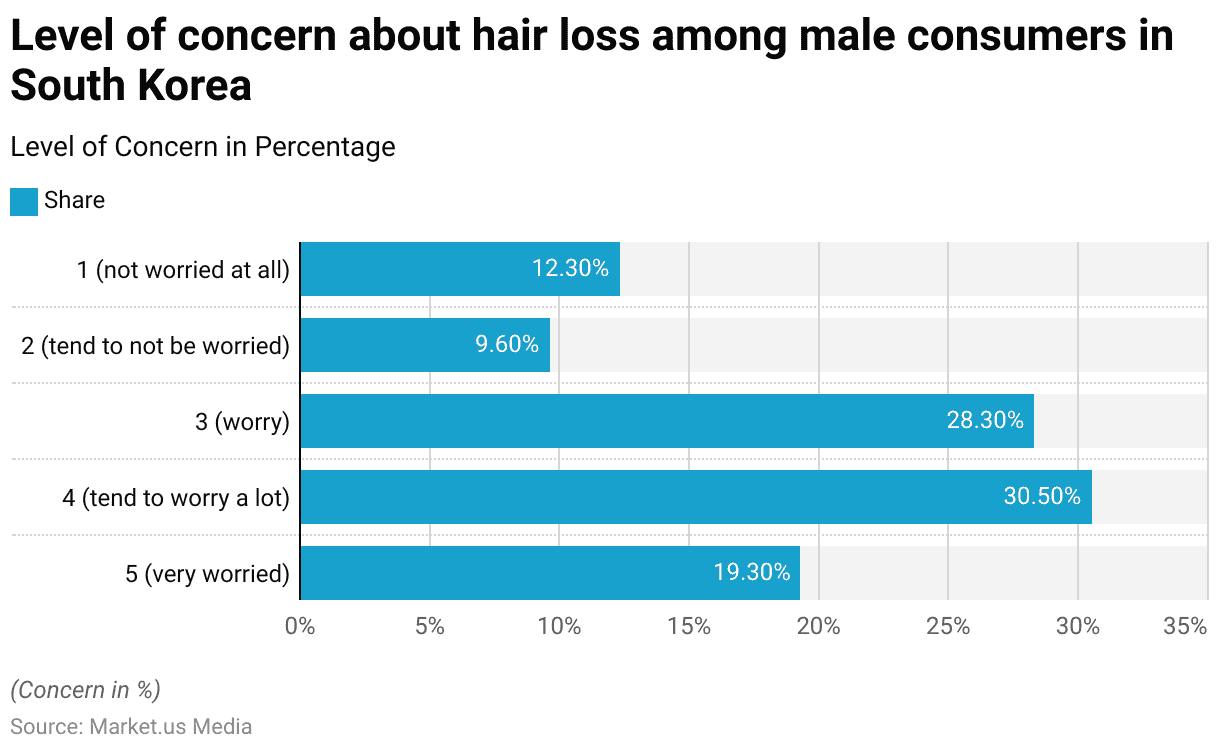
Hair Loss Treatments Used by Men
- In 2022, male consumers in South Korea utilized a variety of treatments to address hair loss.
- The most popular method was the use of hair loss shampoo, employed by 39.80% of respondents.
- Additionally, 15.30% reported the intake of foods believed to combat hair loss, and 14.50% engaged in scalp massages as a preventative or mitigative measure.
- Medication was taken by 12.20% of participants, while 9.20% opted for dietary supplements specifically aimed at reducing hair loss.
- Medical treatments at hospitals or doctors’ offices were sought by 7.40%, closely followed by 7.30% who chose scalp care at hair salons or scalp care clinics.
- Application of ampoules or hair supplements was reported by 7.10%, and a smaller percentage, 4.50%, underwent hair loss-related procedures such as hair transplantation.
- Notably, despite the availability of these treatments, 41.50% of respondents did not use any hair loss treatments, indicating a significant portion of the population either accepts the condition or does not find the available options effective or necessary.
(Source: Statista)
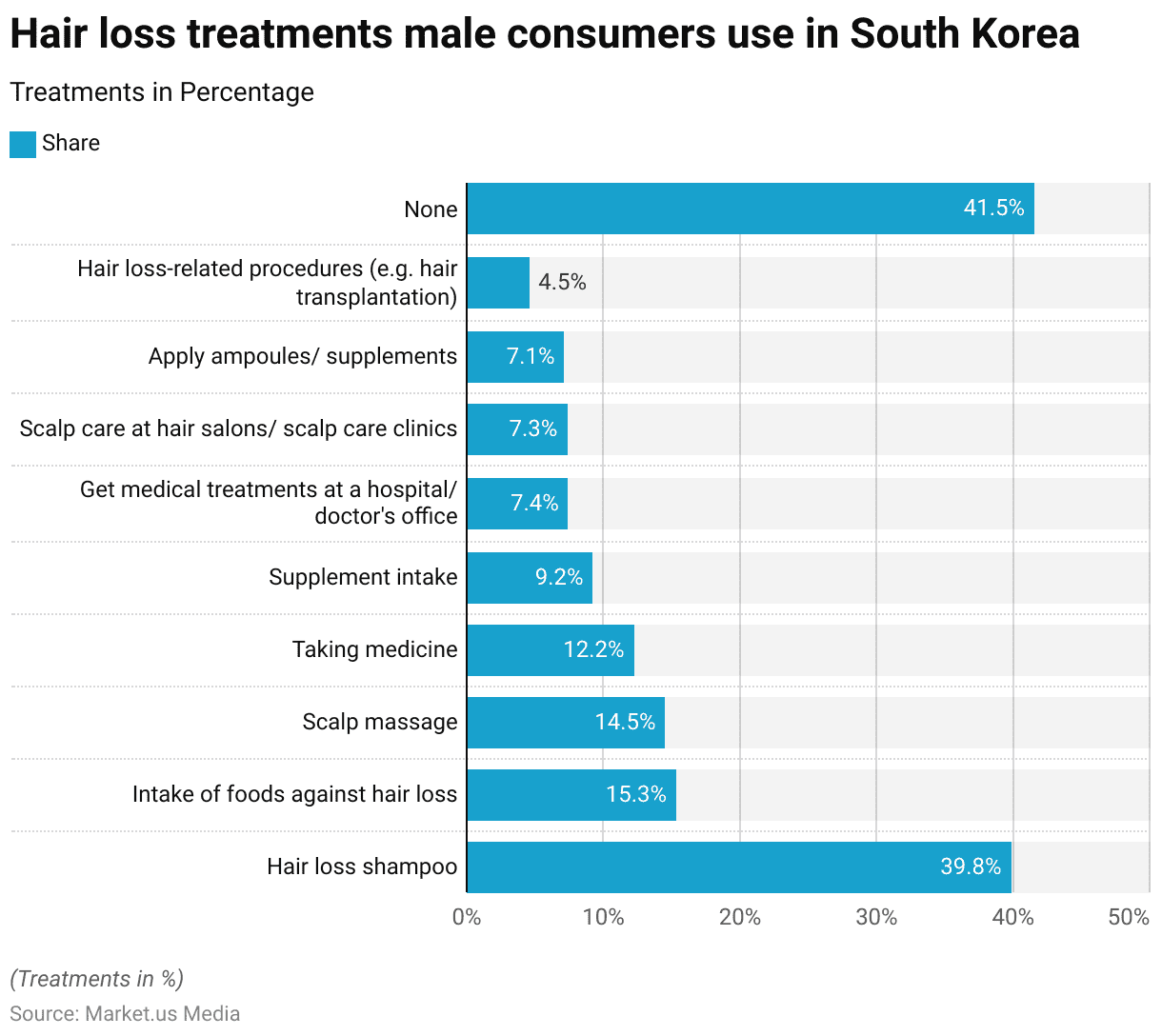
Age Distribution of Male Patients Receiving Hair Loss Treatment
- In 2021, the age distribution of male patients receiving hair loss treatment in South Korea revealed a wide range across different age groups.
- The largest share of patients was in the 30-39 age group, accounting for 25.10% of those treated.
- This was closely followed by those aged 40-49 years, who comprised 22.70% of the patient population.
- The 20-29-year age group also represented a significant portion, with 20.90% seeking treatment.
- The 50-59-year age group made up 15.20% of the patients, while 6.80% were adolescents aged 10-19 years.
- The prevalence of treatment among older age groups decreased significantly, with 6.40% in the 60-69-year range, 1.40% among children aged 0-9 years, 1.30% for those aged 70-79 years, and a minimal 0.20% for individuals aged 80 years and older.
- This distribution highlights a higher tendency for middle-aged men to seek treatment for hair loss, with decreasing treatment rates observed in both younger children and older people.
(Source: Statista)

Hair Loss Treatments Perceived as Effective by Men
- In 2022, perceptions of the effectiveness of various hair loss treatments among male consumers in South Korea varied.
- Hair loss shampoo was considered the most effective, with 46.20% of respondents endorsing it.
- Medications were deemed effective by 17.40%, and the intake of foods believed to combat hair loss was favored by 15.40%.
- Scalp massages were viewed as beneficial by 13.70% of the participants.
- Supplement intake was perceived as effective by 9.40% of respondents, while 8.20% found medical treatments at hospitals or doctors’ offices helpful.
- Both applying ampoules/supplements and receiving scalp care at hair salons or scalp care clinics were rated effective by 7.70% of respondents each.
- Hair loss-related procedures, such as hair transplantation, were considered effective by 5.30%.
- Despite these options, 20.20% of respondents did not perceive any treatment as effective, highlighting a significant level of skepticism or dissatisfaction with the available hair loss solutions.
(Source: Statista)
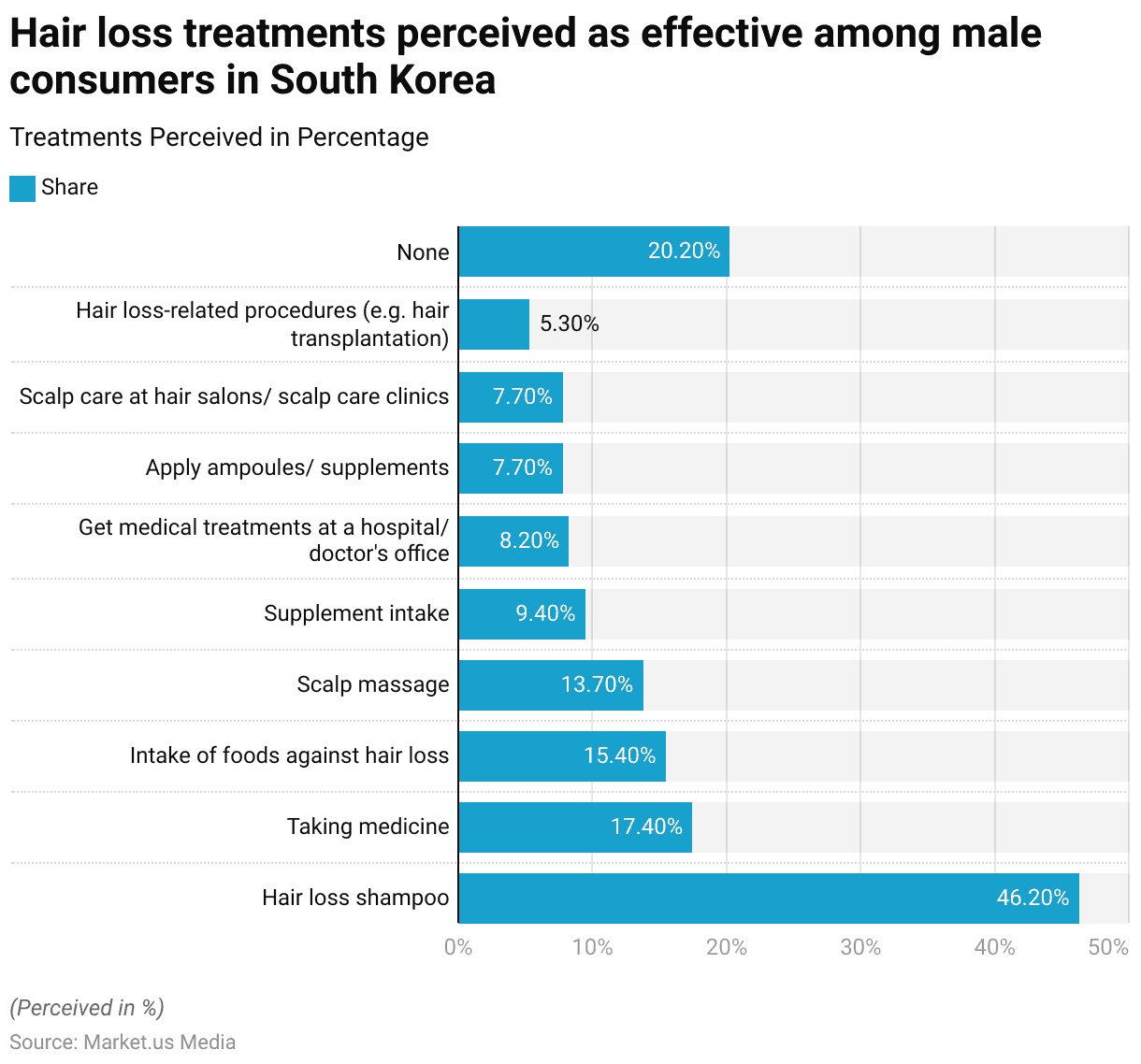
Baldness Dynamics Among Women Statistics
Most Unmet Hair Care Needs According to Women
- In 2023, female consumers in the United States identified several unmet hair care needs, with hair shedding or loss being the most significant, reported by 72% of respondents.
- Thinning hair was also a major concern, affecting 66% of those surveyed.
- Additionally, 60% of women expressed dissatisfaction with dull or lifeless hair, indicating a need for products that enhance hair vitality.
- Greying hair was a concern for half of the respondents, highlighting a demand for effective grey hair management solutions.
- Lastly, scalp conditioning was noted by 23% of the participants, suggesting a lesser but still significant need for products that nurture the scalp.
- These findings underscore a diverse range of hair care issues that are currently underserved in the market.
(Source: Statista)
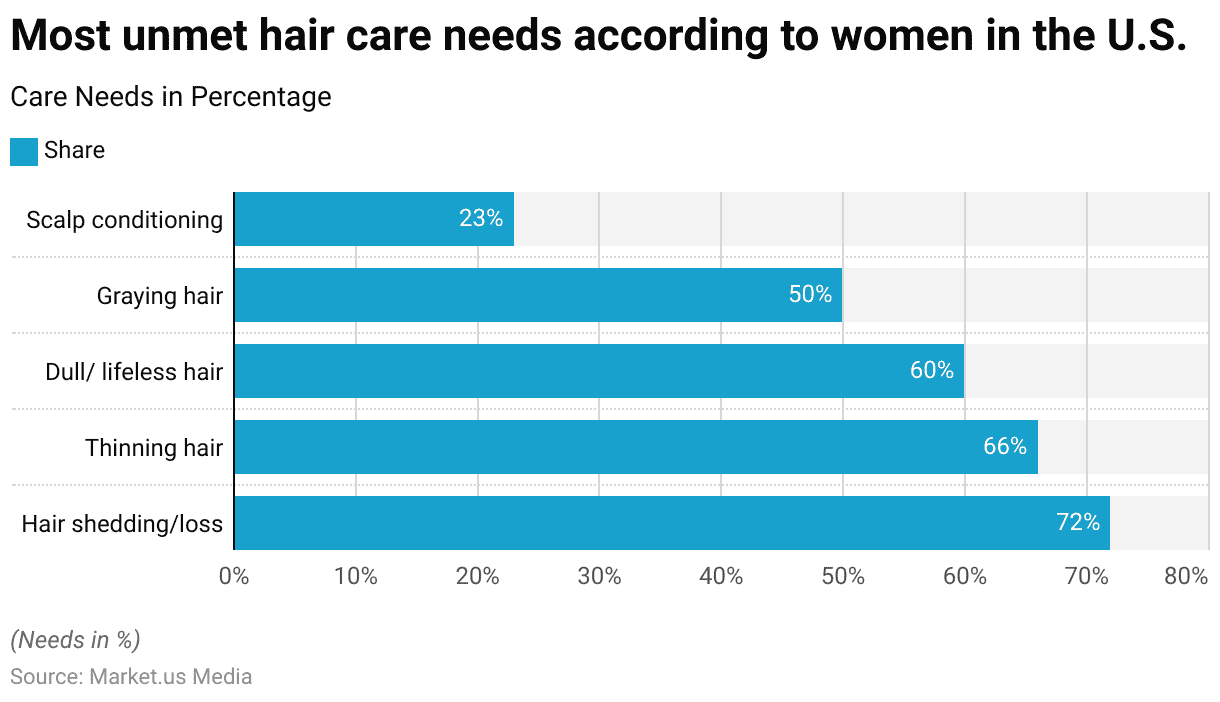
Leading Hair Concerns of Women Between 35 and 44 Years
- In April 2019, women between the ages of 35 and 44 in Singapore reported a variety of hair concerns, with hair loss leading as the most significant issue, affecting 53.28% of respondents.
- Thinning hair was also a prominent concern, cited by 42.36% of women in this age group.
- Dry or damaged hair was another major issue, impacting 37.12% of those surveyed.
- Greying hair was a concern for 35.81%, indicating a substantial demand for color retention or grey hair coverage solutions.
- Oily scalp issues were reported by 31% of the respondents, followed by frizzy hair at 27.07% and limp or flat hair at 26.20%.
- Itchy scalp was a concern for 19.21%, while dull hair, lacking shine, troubled 17.47%.
- Dandruff, brittle hair, overly voluminous hair, excessively curly hair, and excessively straight hair were less common concerns, noted by 14.41%, 12.66%, 5.24%, 4.37%, and 1.75% of respondents, respectively.
- This range of concerns highlights a diverse set of hair care challenges faced by women in this demographic.
(Source: Statista)

Leading Hair Concerns of Women Between 19 and 24 Years
- In April 2019, a survey among women aged 19 to 24 in Singapore revealed a variety of hair concerns.
- The most common issue reported was dry or damaged hair, affecting 47.03% of respondents.
- Oily scalp and hair loss were also significant concerns, cited by 41.26% and 41.08% of participants, respectively.
- Frizzy hair was another prevalent issue, mentioned by 36.19% of the women surveyed.
- Limp or flat hair troubled 27.62%, while 26.40% reported problems with dandruff.
- Thinning hair was a concern for 24.30% of respondents, followed by an itchy scalp affecting 22.03%.
- Dull hair, lacking shine, was noted by 17.31%, and brittle hair by 15.21%.
- Additionally, 11.36% found their hair too straight, while both greying hair and excessively curly hair were concerns for 5.07% each.
- Hair that was deemed too voluminous was the least of concerns, affecting only 4.37%.
- These results highlight a broad spectrum of hair issues faced by young women in this age group in Singapore.
(Source: Statista)

Women’s Attitudes Towards Hair Loss
- In June 2016, a survey in the United States captured women’s perceptions of how thinning hair or hair loss affects their appearance.
- A significant majority, 81% of respondents, believed that these conditions negatively impact a woman’s appearance.
- Furthermore, 55% felt that thinning hair or hair loss makes a woman look older, while 43% associated it with looking less healthy.
- Additionally, 32% of the women surveyed expressed that these hair conditions could make a woman appear less confident.
- These findings underscore the profound influence that hair health can have on personal appearance and perceived vitality and confidence among women.
(Source: Statista)
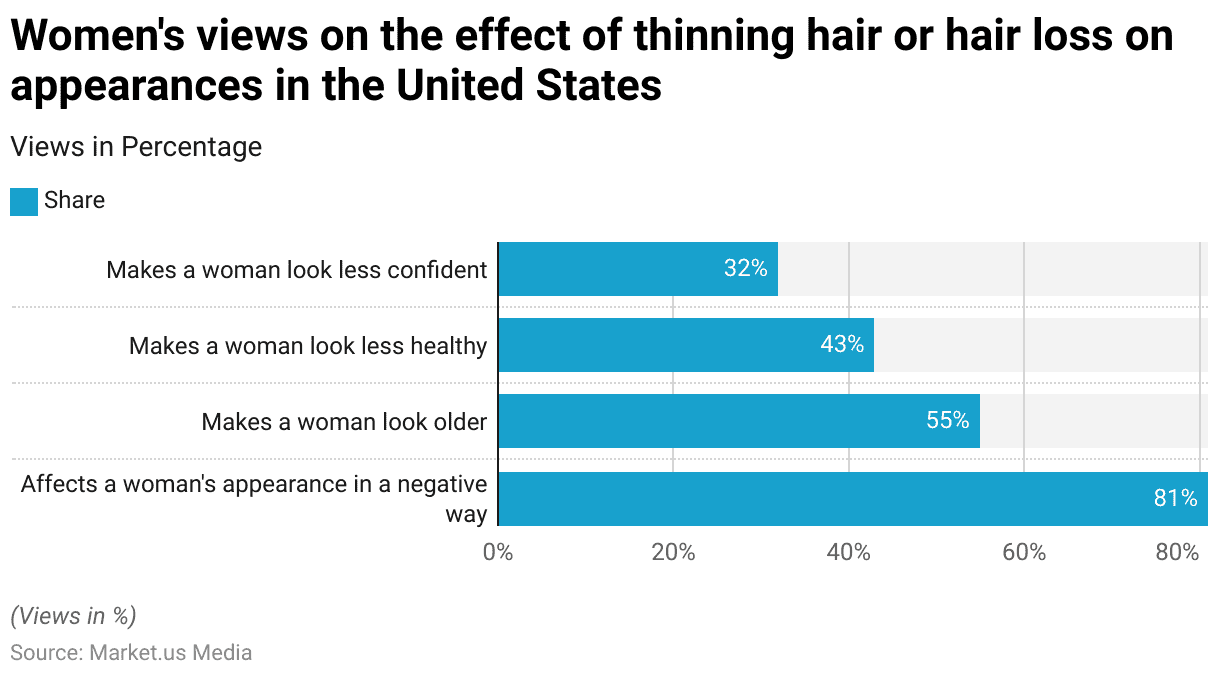
Women’s Hair Treatment and Mask Usage
2014-2017
- From 2014 to 2017, the use of women’s hair conditioning treatments and masks (excluding styling products) in France fluctuated across different frequency categories.
- In 2014, 2,101,000 people used these treatments more than once a week, while 2,160,000 used them once a week, 1,615,000 used them 2 or 3 times a month, and 1,433,000 used them less than 2 or 3 times a month.
- By 2015, the number of users more than once a week had decreased to 1,796,000, while weekly usage remained stable at 2,162,000. However, usage 2 or 3 times a month slightly increased to 1,649,000, and those using it less than 2 or 3 times a month rose to 1,494,000.
- In 2016, more than once-a-week usage rebounded to 1,962,000, weekly use increased to 2,283,000, and the numbers for 2 or 3 times a month and less than 2 or 3 times a month were 1,564,000 and 1,329,000, respectively.
- In 2017, the trend saw a slight decrease for most categories, with 2,056,000 people using it more than once a week and 2,000,000 using it weekly, while 1,563,000 used it 2 or 3 times a month and 1,374,000 used it less frequently.
2018-2020
- By 2018, usage spiked, with 2,174,000 people using these treatments more than once a week and 2,468,000 using them weekly. The 2 or 3 times a month category grew to 1,672,000, while the less than 2 or 3 times a month category saw a slight increase to 1,366,000.
- In 2019, usage dropped again across most categories, with 1,964,000 using treatments more than once a week and 2,164,000 using them weekly. Those using it 2 or 3 times a month and less than 2 or 3 times a month dropped to 1,377,000 and 1,191,000, respectively.
- In 2020, the number of users more than once a week declined to 1,925,000, while weekly usage rose slightly to 2,275,000. Usage 2 or 3 times a month remained steady at 1,557,000, and the less frequent users totaled 1,253,000.
- This data reflects shifting trends in hair conditioning and mask usage over the six years in France.
(Source: Statista)

Baldness Treatments and Remedies Statistics
Usage of Hair Regrowth Products
2012-2017
- From 2012 to 2024, the usage of hair regrowth products in the United States saw a gradual increase.
- In 2012, 9.84 million people reported using hair regrowth products, while 297.21 million did not, and 6.82 million either did not know or provided no answer.
- In 2013, the number of users slightly decreased to 9.51 million, while the non-users dropped to 290.8 million, and those unsure rose significantly to 15.74 million.
- The following year, in 2014, the number of users returned to 9.84 million, with 290.48 million not using the products and 18.06 million uncertain.
- By 2015, the number of users grew to 9.9 million, with 294.03 million not using the products and 16.81 million not responding.
- The number of users continued to rise, reaching 10.2 million in 2016, with non-users at 297.36 million and 15.51 million unsure.
- In 2017, 10.56 million people used hair regrowth products, while 298.36 million did not, and 16.23 million were unsure.
2018-2024
- The usage significantly increased in 2018 to 12.09 million, with non-users and uncertain respondents at 298.77 million and 16.31 million, respectively.
- In 2019, the number of users dropped to 11.34 million. But non-users increased to 302.88 million, and 16.04 million were uncertain.
- By 2020, the number of people using hair regrowth products climbed to 12.42 million, with non-users at 303.63 million and 16.59 million unsure.
- In 2021, the number of users rose slightly to 12.5 million. While non-users reached 306.46 million, and 16.57 million remained unsure.
- In 2022, 12.68 million people reported using these products, with 308.6 million not using them and 16.69 million uncertain.
- In 2023, usage increased to 12.82 million, with non-users at 310.73 million and 16.8 million still uncertain.
- The forecast for 2024 shows continued growth in usage. With 12.94 million people expected to use hair regrowth products, 312.83 million not using them, and 16.92 million unsure or unresponsive.
- Over the years, this data reflects a steady rise in the usage of hair regrowth products in the U.S. population.
(Source: Statista)
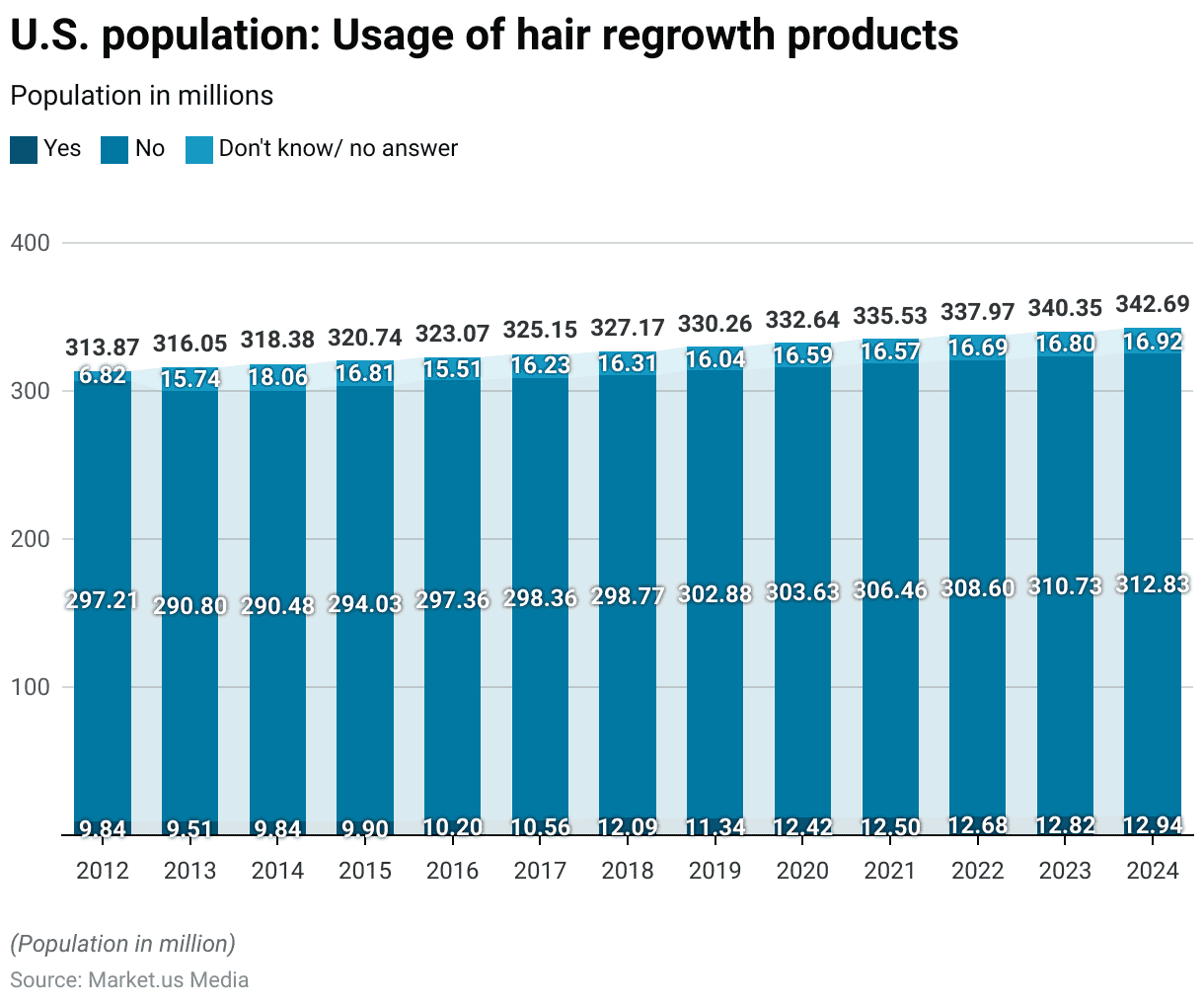
Scalp Care or Hair Loss Treatment Service Usage
- As of July 2023, the usage rate of scalp care or hair loss treatment services in South Korea varied across different age groups.
- The highest usage was observed among individuals aged 30-39 years, with 14% of respondents utilizing these services.
- The 19-29 year and 40-49-year age groups both had a usage rate of 11%, while 12% of those aged 50-59 years sought treatment.
- Among younger individuals aged 13-19 years, only 1% reported using scalp care or hair loss services, and the rate among those aged 60 and older stood at 6%.
- This data indicates that middle-aged adults in South Korea are more likely to use these services than younger and older populations.
(Source: Statista)
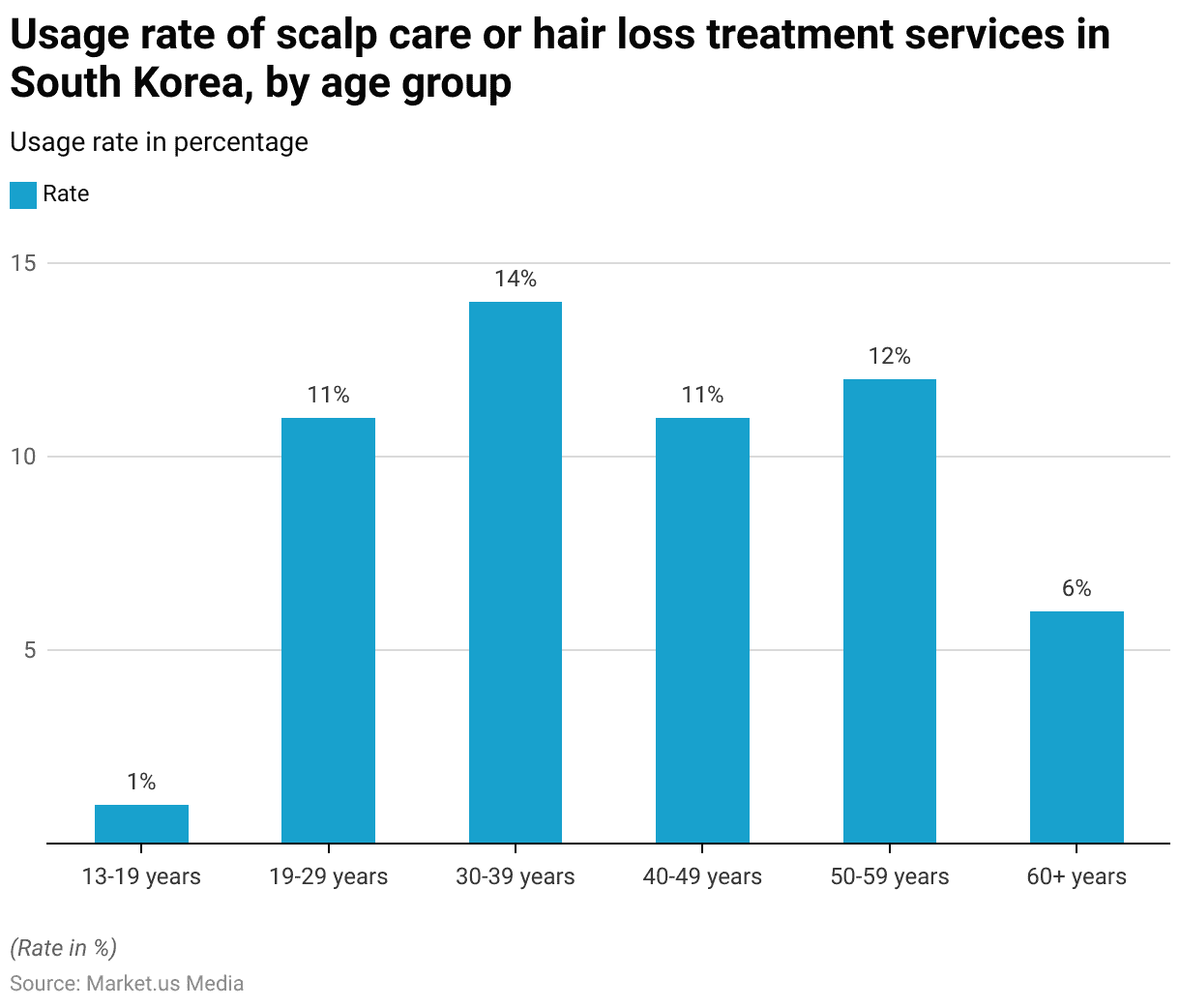
Usage Rate of Scalp Care or Hair Loss Treatment Services
- The usage rate of scalp care or hair loss treatment services in South Korea showed fluctuating trends from 2019 to 2023.
- From 2019 to 2021, the usage rate remained steady at 7%.
- However, in 2022, there was a decline, with the usage rate dropping to 5%.
- In 2023, the rate rebounded significantly to 9%, indicating renewed interest or demand for these services after the previous year’s decline.
- This trend suggests a growing awareness or need for scalp care and hair loss treatments in recent years.
(Source: Statista)
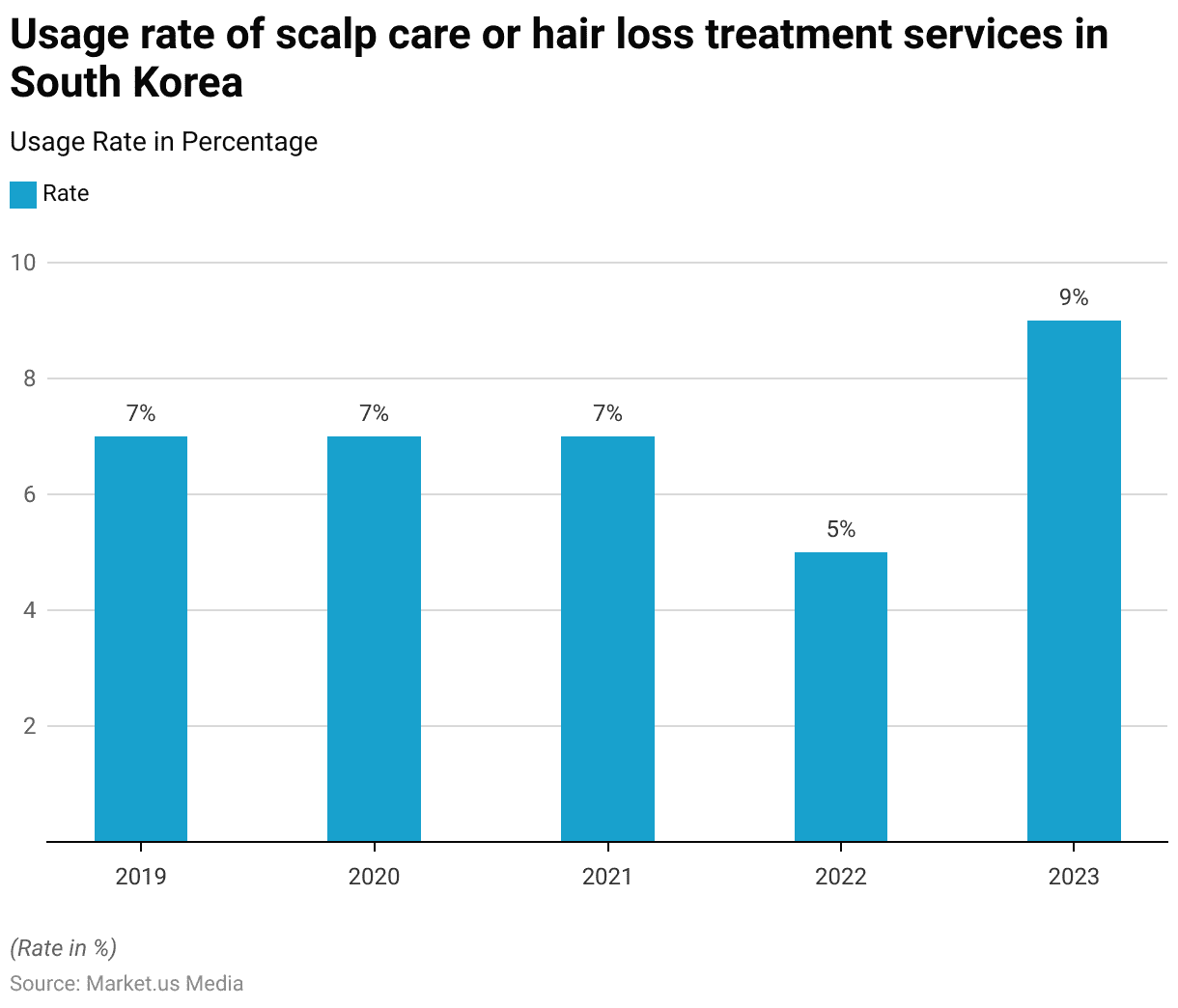
Global Alopecia Drugs Market Size
- The global alopecia drugs market is projected to experience steady growth from 2023 to 2033.
- In 2023, the market size is estimated at USD 9.0 billion, and it is expected to increase to USD 9.9 billion by 2024.
- By 2025, the market is forecasted to reach USD 10.9 billion, followed by USD 11.9 billion in 2026.
- This upward trend continues in 2027, with the market size reaching USD 13.1 billion and USD 14.4 billion in 2028.
- In subsequent years, the market is anticipated to grow significantly, reaching USD 15.9 billion by 2029 and USD 17.4 billion by 2030.
- The growth accelerates further, with the market projected to hit USD 19.2 billion by 2031, USD 21.0 billion in 2032, and USD 23.1 billion by 2033.
- This expansion reflects a robust demand for alopecia treatments globally over the next decade.
(Source: market.us)
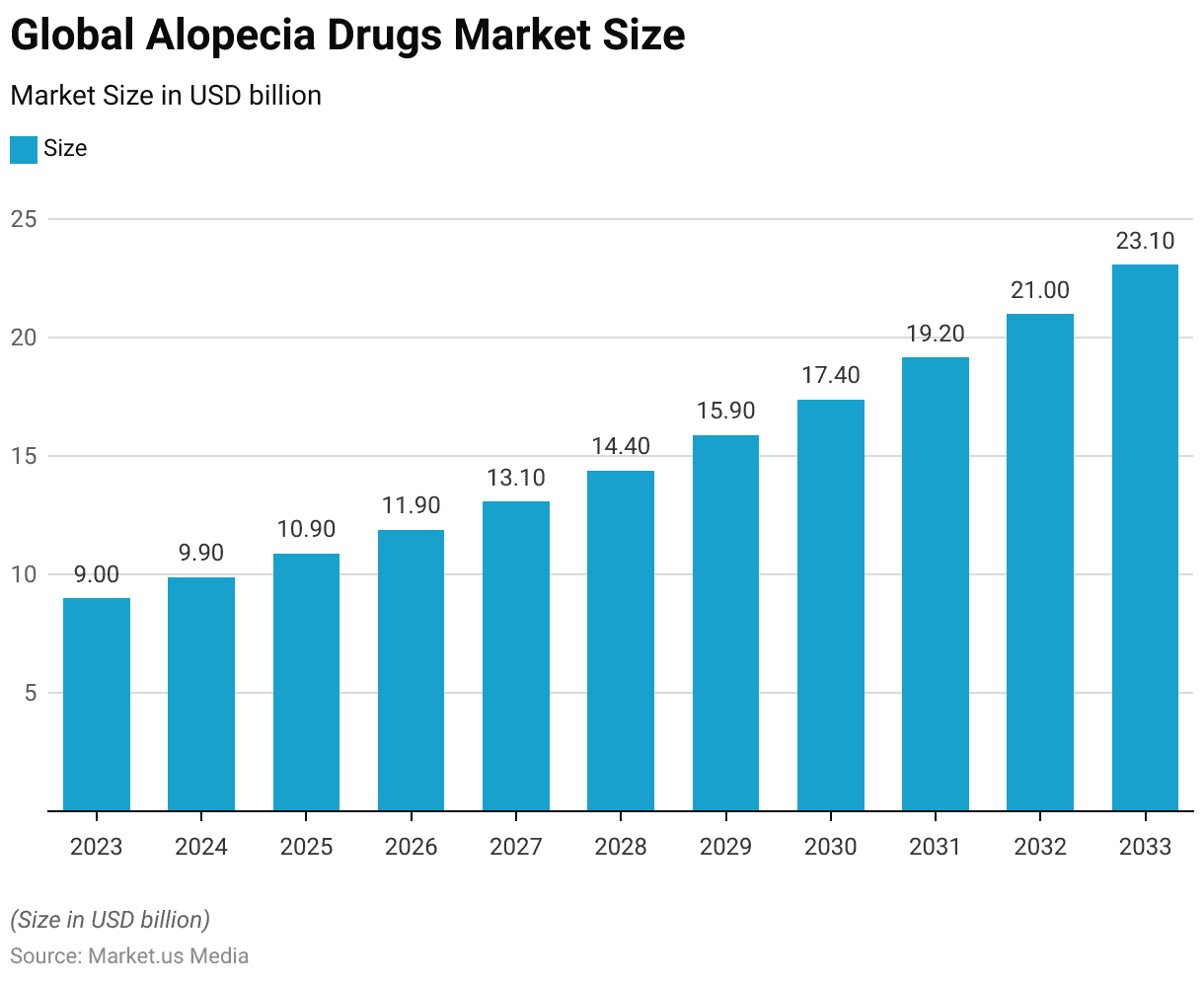
Value Market Share of Hair Loss Treatment Products
- In 2021, the hair loss treatment products market in Spain was dominated by a variety of manufacturers, with “Resto” brands holding the largest value market share at 27.90%.
- Cantabria Labs followed with a 14.10% market share, while Lacer accounted for 11.60%.
- Reig Jofre captured 9.50% of the market, and Vinas held an 8.80% share.
- ISDIN had a 6.40% market share, and Ducray accounted for 4.70%.
- Galderma followed closely with a 4.50% share, while both Rene Furterer and Klorane each held 4.10%.
- Phyto rounded out the market with a 3.80% share.
- These figures highlight the competitive nature of the hair loss treatment product market in Spain.
(Source: Statista)
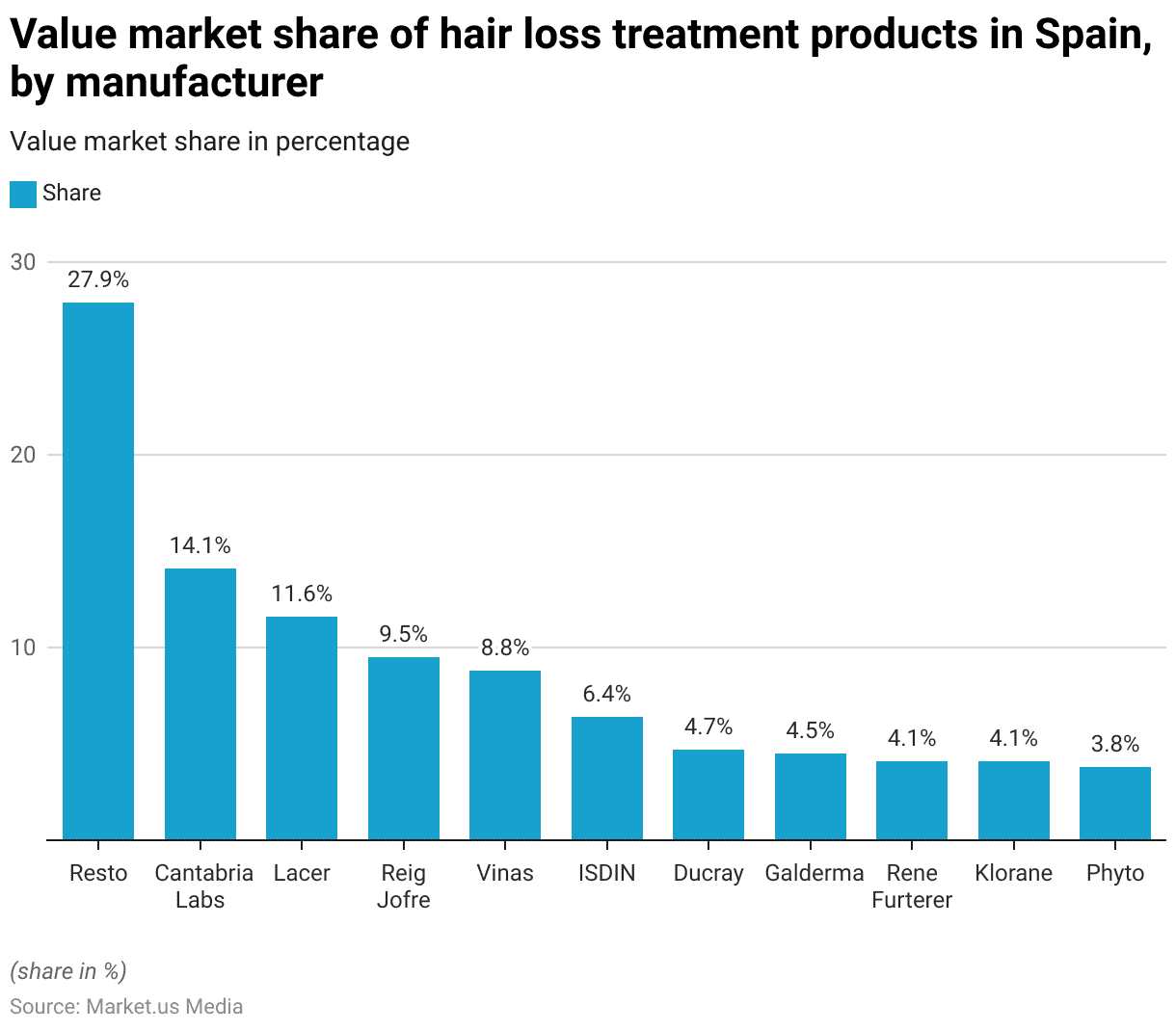
Volume of Performed Global Surgical Hair Restoration Procedures
- The volume of surgical hair restoration procedures performed worldwide saw a significant increase from 2006 to 2020.
- In 2006, 225,779 procedures were conducted, which rose to 252,002 in 2008 and further to 279,381 by 2010.
- The upward trend continued, with 310,624 procedures performed in 2012 and 397,048 in 2014.
- Substantial growth occurred in 2016, with the number of procedures jumping to 635,189.
- By 2019, the volume peaked at 735,312 procedures.
- However, in 2020, there was a slight decline to 703,183, likely influenced by the global pandemic.
- This overall growth reflects the increasing popularity and demand for surgical hair restoration over the years.
(Source: Statista)

Baldness Treatment Cost Statistics
Hair Transplant Cost – By Country
- In 2020 and 2021, the total cost of hair transplants varied significantly across different countries.
- Canada had the highest cost, with an average of USD 17,500, followed by Australia at USD 13,751 and the United States at USD 13,610.
- In the United Kingdom, the procedure cost an average of USD 8,050, while in Germany, the cost was slightly lower at USD 7,372.
- Thailand and Poland offered more affordable options at USD 5,758 and USD 5,646, respectively.
- Hungary and India had even lower costs, at USD 3,650 and USD 3,350, while Mexico averaged USD 3,202.
- Turkey had the lowest cost for hair transplants, with an average of USD 2,676, making it a popular destination for those seeking more affordable treatment options.
(Source: Statista)
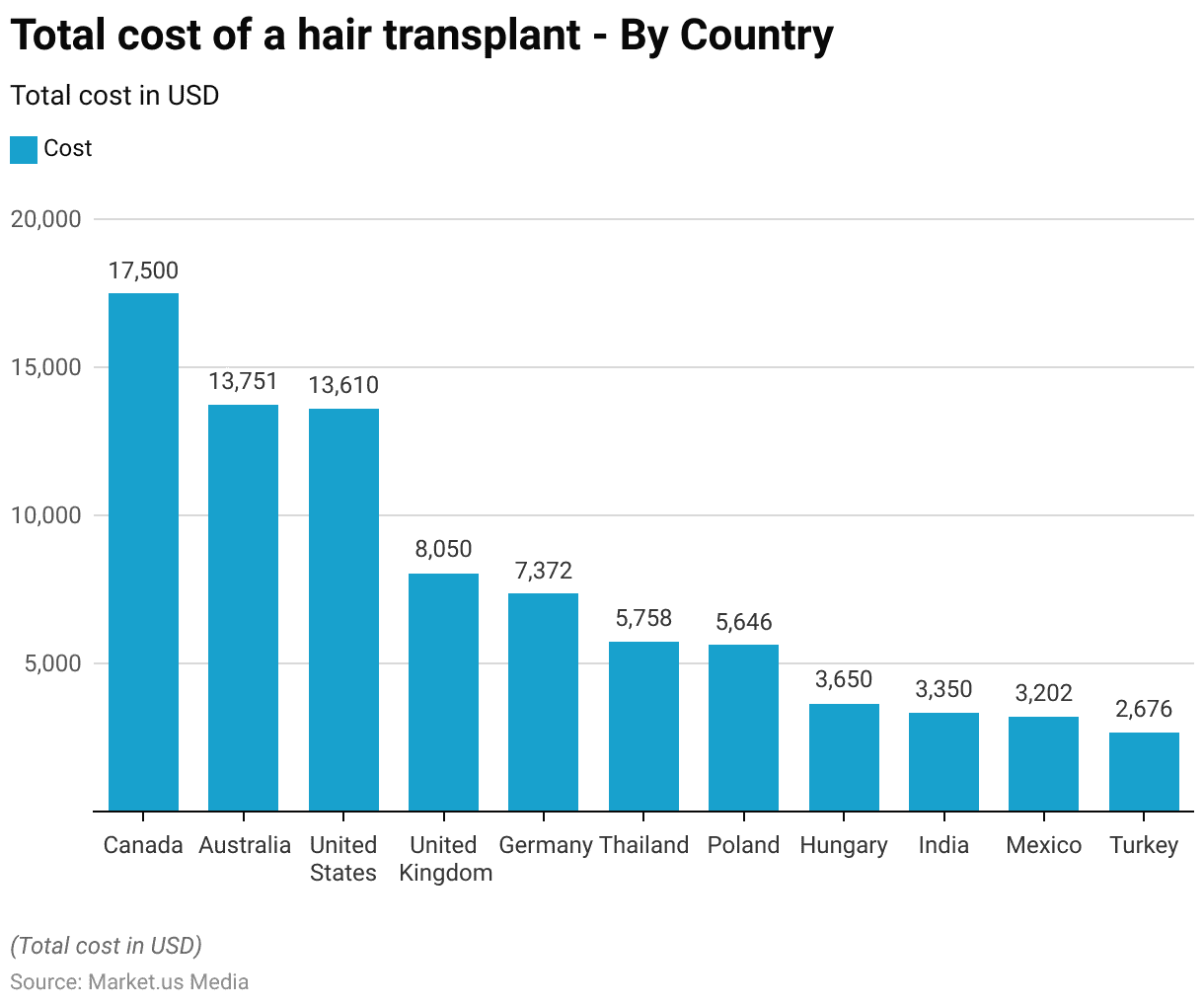
Cost Per Graft for a Hair Transplant – By Country
- In 2020 and 2021, the cost per graft for hair transplants varied significantly across countries.
- Canada had the highest cost at USD 7 per graft, followed by Australia at USD 5.5 and the United States at USD 5.44.
- In the United Kingdom, the cost per graft was USD 3.22, while in Germany, it was slightly lower at USD 2.93.
- Poland offered a rate of USD 2.74 per graft, and Thailand’s cost was USD 2.3.
- More affordable options were found in Hungary at USD 1.47, India at USD 1.34, Mexico at USD 1.28, and Turkey, which had the lowest cost per graft at USD 1.07.
- These figures highlight the varying price points for hair transplant procedures across the world.
(Source: Statista)

Key Investment Trends
- Between 2010 and 2022, the average annual expenditure on hair care products per consumer unit in the United States showed fluctuating trends.
- In 2010, consumers spent an average of USD 62, which slightly increased to USD 67.88 in 2011.
- The expenditure then dipped to USD 61.69 in 2012 before rising to USD 64.49 in 2013.
- A consistent upward trend followed, with spending reaching USD 69.53 in 2014 and USD 73.43 in 2015.
- The expenditure peaked at USD 83.07 in 2016 and USD 89.95 in 2017 before dropping to USD 73.4 in 2018.
- In 2019, the average expenditure rose again to USD 78.7, but it declined to USD 64.7 in 2020, likely influenced by the pandemic.
- By 2021, spending rebounded to USD 77.17, and in 2022, it further increased to USD 85.53, reflecting a recovery and growing consumer investment in hair care products.
(Source: Statista)
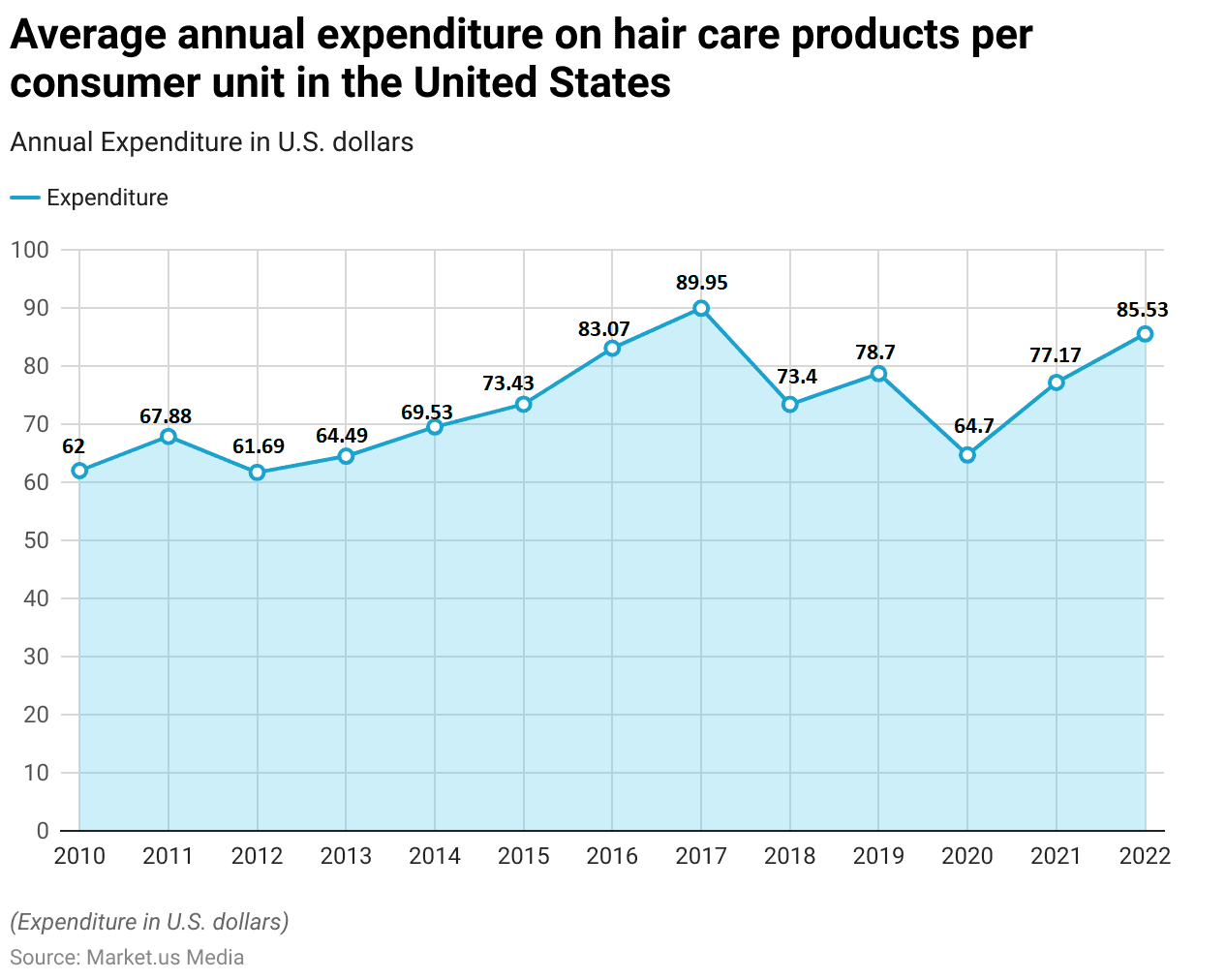
Innovations and Developments in Hair Transplant Technology
- Recent advancements in hair transplant technology have revolutionized the field, significantly enhancing both the efficacy and safety of procedures.
- Innovations such as robotic systems, notably the ARTAS and Ke-Bot, are pivotal, offering high precision in hair follicle harvesting, which minimizes damage and improves outcomes.
- For instance, the Ke-Bot Mobile provides crucial data like graft implantation numbers and hair density, aiding both pre- and post-surgical planning and assessment to optimize results.
- Additionally, non-surgical methods like Platelet-Rich Plasma (PRP) therapy have emerged as complementary treatments. PRP involves processing a patient’s blood to concentrate platelets, which are then injected into the scalp.
- This stimulates hair growth by promoting angiogenesis and collagen production, enhancing the overall health and viability of transplanted follicles.
- The field is also exploring frontier technologies such as stem cell therapy and hair cloning. Stemson Therapeutics and Aderans, for example, are advancing cell therapy that utilizes patients’ hair and skin cells to regenerate hair follicles, presenting a potential long-term solution for hair loss.
- As technology and techniques evolve, the hair transplant market is poised for significant growth, with estimations suggesting an expansion from USD 6.9 billion in 2023 to around USD 38.8 billion by 2032.
- This growth is fueled by the increasing demand for hair restoration solutions and the continuous advancements in technology, which improve both the appearance and the success rates of hair transplant procedures.
(Source: UnitedCare, Hair Transplant Institute, Bosley Hair Transplant, Hair Transplant TR)
Recent Developments
Acquisitions and Mergers:
- Bosley acquires Hair Club: In 2023, Bosley, a leading hair restoration company, acquired Hair Club for $150 million, merging two major players in the hair restoration industry. This acquisition is aimed at expanding Bosley’s offerings in non-surgical hair loss treatments and expanding its customer base.
- Aclaris Therapeutics acquires Confluence Life Sciences: In early 2023, Aclaris Therapeutics, a company specializing in treatments for hair loss and skin conditions, acquired Confluence Life Sciences for $100 million. The acquisition focuses on advancing Aclaris’ research and development of treatments for alopecia and other hair-related conditions.
New Product Launches:
- Pfizer launches new topical treatment for androgenetic alopecia: In late 2023, Pfizer introduced a topical treatment targeting androgenetic alopecia (male pattern baldness). The product has shown a 20% improvement in hair regrowth for early-stage baldness patients during clinical trials.
- Johnson & Johnson launches PRP hair treatment kits: In March 2024, Johnson & Johnson released a platelet-rich plasma (PRP) kit, aimed at professionals offering hair restoration services. PRP treatments are gaining traction as a non-invasive solution for stimulating hair growth.
Funding:
- Follica raises $55 million for hair regeneration therapy: In 2023, Follica, a biotechnology company, secured $55 million in Series C funding to develop its hair follicle regeneration therapy. The funding will be used to advance clinical trials and bring this innovative solution to market by 2025.
- Hims & Hers secures $75 million for expanding baldness treatments: In 2023, Hims & Hers, a telehealth company offering hair loss solutions, raised $75 million to expand its online platform and deliver more personalized baldness treatments, such as finasteride and minoxidil.
Technological Advancements:
- Stem cell therapy for hair regeneration: By 2025, 30% of hair loss treatments are expected to include stem cell therapy, which shows promising results for regenerating hair follicles and offering long-term solutions for baldness.
- AI-driven hair loss diagnostics: Several companies are integrating AI into their diagnostic tools, allowing for more accurate and personalized treatment plans. By 2026, 25% of hair restoration clinics are projected to use AI-driven tools to enhance treatment outcomes.
Conclusion
Baldness Statistics – Baldness, particularly androgenetic alopecia, is a common condition affecting millions globally, with men more frequently impacted than women.
Factors such as genetics, hormonal changes, stress, and lifestyle contribute to hair loss. The growing demand for effective treatments, including shampoos, medications, and hair transplants, has led to the steady expansion of the global hair loss treatment market.
Advances in medical technology and increased consumer interest in aesthetic solutions are expected to drive continued growth in the coming years.
FAQs
Baldness is primarily caused by genetics (androgenetic alopecia), hormonal changes, aging, and certain medical conditions. Stress, poor nutrition, and environmental factors may also contribute.
Baldness is more common in men, with male pattern baldness affecting a larger percentage of males than females. However, women also experience hair thinning, particularly after menopause.
While genetic baldness cannot be fully prevented, early intervention with treatments like medications, lifestyle changes, and hair care routines can slow hair loss.
Common treatments include over-the-counter and prescription medications (such as minoxidil and finasteride), hair transplants, laser therapy, and specialized shampoos or supplements designed to promote hair growth.
Hair transplants are considered a long-term solution, as transplanted hair is typically resistant to the factors that cause hair loss. However, results can vary, and ongoing hair care may be required.
Yes, stress can lead to temporary hair loss, a condition known as telogen effluvium. It typically resolves once the stress is managed, but chronic stress may worsen other forms of hair loss.
A balanced diet rich in vitamins and minerals, such as biotin, iron, and zinc, supports healthy hair growth. Nutritional deficiencies can contribute to hair thinning or loss.
Discuss your needs with our analyst
Please share your requirements with more details so our analyst can check if they can solve your problem(s)



